NSK Tapered Roller Bearings
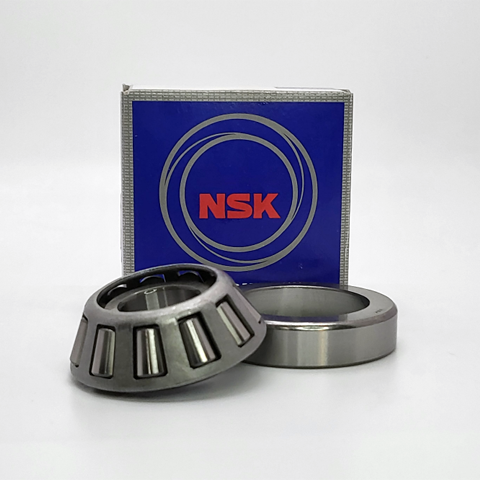
NSK NSK Tapered Roller Bearings, Single-Row Metric Design HR32052XJ ,D=260
NSK Tapered Roller Bearings, Single-Row Metric Design HR32052XJ ,D=260 Bearing Numbers Boundary Dimensions (mm) Basic Load Ratings (kN) Limiting Speeds (min-1) ISO355 Dimensions Series approx. Constant e Axial Load Factors Mass (kg) approx. d D T B C Cone r min. Cup r min. Cr C0r Grease Oil Y1 Y0 HR32052XJ 260 400 87 87 65 5 4 1160 2160 800 1100 4FC 0.43 1.4 0.76 38.5 DESIGN, TYPES, AND FEATURES Tapered roller bearings are designed so the apices of the cones formed by the raceways of the inner and outer rings and the inner ring rollers all coincide at one point on the axis of the bearing. When a radial load is imposed, a component axial force occurs; therefore, it is necessary to use two bearings in opposition or some other multiple-bearing arrangement. For Metric Series medium-angle or steep-angle tapered roller bearings, the respective contact angle designation C or D is added after the bore number. For normal-angle tapered roller bearings, no contact angle designation is used. Medium-angle tapered roller bearings are primarily used for the pinion shafts of differential gears in automobiles. Some bearings with high load capacity (HR Series) contain a J suffix that indicates they conform to ISO specifications for outer ring back face raceway diameter, outer ring width, and contact angle. Therefore, the inner ring assembly and outer ring of bearings with a J suffix are internationally interchangeable. Some Metric Series tapered roller bearings specified by ISO 355 have different dimensions from past Series 3XX bearings. Some of these are listed in the bearing tables. These conform to ISO specifications for the small-end diameter of the inner ring and contact angle. The inner and outer ring assemblies are internationally interchangeable. The bearing designation structure, which has changed from the past, is listed below: Inch Series bearings also exist. Inner ring assemblies and outer rings are approximately formulated as follows (excluding four-row tapered roller bearings): Various arrangements of tapered roller bearings (excluding single-row bearings) are available. The cages of tapered roller bearings are usually made of pressed steel. Table 1 Design and Features of Tapered Roller Bearing Arrangements Design Arrangement Ex. Bearing Designation Features Back-to-back HR30210JDB+KLR10 Two standard bearings are combined. The bearing clearances are adjusted by inner ring spacers or outer ring spacers. The inner rings, outer rings, and spacers are marked with serial numbers and mating marks. Components with the same serial number can be assembled by referring to the matching indications. Face-to-face HR30210JDF+KR KBE Type 100KBE31+L The KBE type is a back-to-back arrangement of bearings with an integrated outer ring spacer. The KH type is a face-to-face arrangement in which the inner rings are integrated. Since the bearing clearance is adjusted using spacers, components must have the same serial number for assembly with reference to the matching indications. KH Type 110KH31+K
$4,717.92
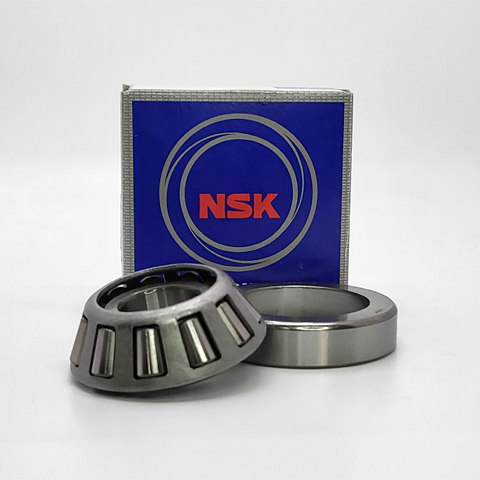
NSK NSK Tapered Roller Bearings, Single-Row Metric Design HR32048XJ ,D=240
NSK Tapered Roller Bearings, Single-Row Metric Design HR32048XJ ,D=240 Bearing Numbers Boundary Dimensions (mm) Basic Load Ratings (kN) Limiting Speeds (min-1) ISO355 Dimensions Series approx. Constant e Axial Load Factors Mass (kg) approx. d D T B C Cone r min. Cup r min. Cr C0r Grease Oil Y1 Y0 HR32048XJ 240 360 76 76 57 4 3 920 1730 850 1200 4FD 0.46 1.3 0.72 26.2 DESIGN, TYPES, AND FEATURES Tapered roller bearings are designed so the apices of the cones formed by the raceways of the inner and outer rings and the inner ring rollers all coincide at one point on the axis of the bearing. When a radial load is imposed, a component axial force occurs; therefore, it is necessary to use two bearings in opposition or some other multiple-bearing arrangement. For Metric Series medium-angle or steep-angle tapered roller bearings, the respective contact angle designation C or D is added after the bore number. For normal-angle tapered roller bearings, no contact angle designation is used. Medium-angle tapered roller bearings are primarily used for the pinion shafts of differential gears in automobiles. Some bearings with high load capacity (HR Series) contain a J suffix that indicates they conform to ISO specifications for outer ring back face raceway diameter, outer ring width, and contact angle. Therefore, the inner ring assembly and outer ring of bearings with a J suffix are internationally interchangeable. Some Metric Series tapered roller bearings specified by ISO 355 have different dimensions from past Series 3XX bearings. Some of these are listed in the bearing tables. These conform to ISO specifications for the small-end diameter of the inner ring and contact angle. The inner and outer ring assemblies are internationally interchangeable. The bearing designation structure, which has changed from the past, is listed below: Inch Series bearings also exist. Inner ring assemblies and outer rings are approximately formulated as follows (excluding four-row tapered roller bearings): Various arrangements of tapered roller bearings (excluding single-row bearings) are available. The cages of tapered roller bearings are usually made of pressed steel. Table 1 Design and Features of Tapered Roller Bearing Arrangements Design Arrangement Ex. Bearing Designation Features Back-to-back HR30210JDB+KLR10 Two standard bearings are combined. The bearing clearances are adjusted by inner ring spacers or outer ring spacers. The inner rings, outer rings, and spacers are marked with serial numbers and mating marks. Components with the same serial number can be assembled by referring to the matching indications. Face-to-face HR30210JDF+KR KBE Type 100KBE31+L The KBE type is a back-to-back arrangement of bearings with an integrated outer ring spacer. The KH type is a face-to-face arrangement in which the inner rings are integrated. Since the bearing clearance is adjusted using spacers, components must have the same serial number for assembly with reference to the matching indications. KH Type 110KH31+K
$2,800.72
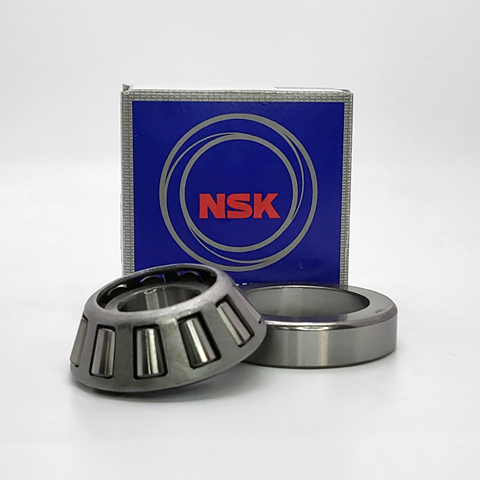
NSK NSK Tapered Roller Bearings, Single-Row Metric Design HR32044XJ ,D=220
NSK Tapered Roller Bearings, Single-Row Metric Design HR32044XJ ,D=220 Bearing Numbers Boundary Dimensions (mm) Basic Load Ratings (kN) Limiting Speeds (min-1) ISO355 Dimensions Series approx. Constant e Axial Load Factors Mass (kg) approx. d D T B C Cone r min. Cup r min. Cr C0r Grease Oil Y1 Y0 HR32044XJ 220 340 76 76 57 4 3 885 1610 950 1300 4FD 0.43 1.4 0.77 24.4 DESIGN, TYPES, AND FEATURES Tapered roller bearings are designed so the apices of the cones formed by the raceways of the inner and outer rings and the inner ring rollers all coincide at one point on the axis of the bearing. When a radial load is imposed, a component axial force occurs; therefore, it is necessary to use two bearings in opposition or some other multiple-bearing arrangement. For Metric Series medium-angle or steep-angle tapered roller bearings, the respective contact angle designation C or D is added after the bore number. For normal-angle tapered roller bearings, no contact angle designation is used. Medium-angle tapered roller bearings are primarily used for the pinion shafts of differential gears in automobiles. Some bearings with high load capacity (HR Series) contain a J suffix that indicates they conform to ISO specifications for outer ring back face raceway diameter, outer ring width, and contact angle. Therefore, the inner ring assembly and outer ring of bearings with a J suffix are internationally interchangeable. Some Metric Series tapered roller bearings specified by ISO 355 have different dimensions from past Series 3XX bearings. Some of these are listed in the bearing tables. These conform to ISO specifications for the small-end diameter of the inner ring and contact angle. The inner and outer ring assemblies are internationally interchangeable. The bearing designation structure, which has changed from the past, is listed below: Inch Series bearings also exist. Inner ring assemblies and outer rings are approximately formulated as follows (excluding four-row tapered roller bearings): Various arrangements of tapered roller bearings (excluding single-row bearings) are available. The cages of tapered roller bearings are usually made of pressed steel. Table 1 Design and Features of Tapered Roller Bearing Arrangements Design Arrangement Ex. Bearing Designation Features Back-to-back HR30210JDB+KLR10 Two standard bearings are combined. The bearing clearances are adjusted by inner ring spacers or outer ring spacers. The inner rings, outer rings, and spacers are marked with serial numbers and mating marks. Components with the same serial number can be assembled by referring to the matching indications. Face-to-face HR30210JDF+KR KBE Type 100KBE31+L The KBE type is a back-to-back arrangement of bearings with an integrated outer ring spacer. The KH type is a face-to-face arrangement in which the inner rings are integrated. Since the bearing clearance is adjusted using spacers, components must have the same serial number for assembly with reference to the matching indications. KH Type 110KH31+K
$2,349.22
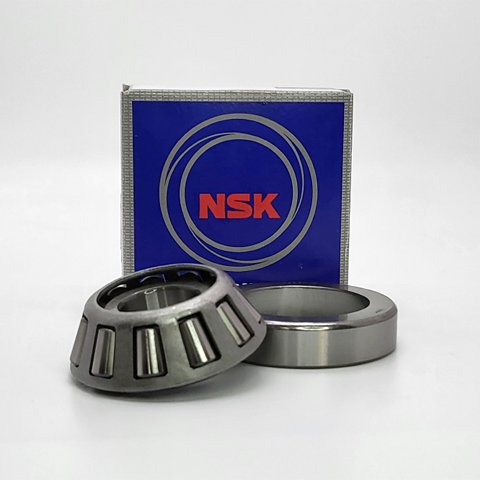
NSK NSK Tapered Roller Bearings, Single-Row Metric Design HR32040XJ ,D=200
NSK Tapered Roller Bearings, Single-Row Metric Design HR32040XJ ,D=200 Bearing Numbers Boundary Dimensions (mm) Basic Load Ratings (kN) Limiting Speeds (min-1) ISO355 Dimensions Series approx. Constant e Axial Load Factors Mass (kg) approx. d D T B C Cone r min. Cup r min. Cr C0r Grease Oil Y1 Y0 HR32040XJ 200 310 70 70 53 3 2.5 760 1370 1000 1400 4FD 0.43 1.4 0.77 18.9 DESIGN, TYPES, AND FEATURES Tapered roller bearings are designed so the apices of the cones formed by the raceways of the inner and outer rings and the inner ring rollers all coincide at one point on the axis of the bearing. When a radial load is imposed, a component axial force occurs; therefore, it is necessary to use two bearings in opposition or some other multiple-bearing arrangement. For Metric Series medium-angle or steep-angle tapered roller bearings, the respective contact angle designation C or D is added after the bore number. For normal-angle tapered roller bearings, no contact angle designation is used. Medium-angle tapered roller bearings are primarily used for the pinion shafts of differential gears in automobiles. Some bearings with high load capacity (HR Series) contain a J suffix that indicates they conform to ISO specifications for outer ring back face raceway diameter, outer ring width, and contact angle. Therefore, the inner ring assembly and outer ring of bearings with a J suffix are internationally interchangeable. Some Metric Series tapered roller bearings specified by ISO 355 have different dimensions from past Series 3XX bearings. Some of these are listed in the bearing tables. These conform to ISO specifications for the small-end diameter of the inner ring and contact angle. The inner and outer ring assemblies are internationally interchangeable. The bearing designation structure, which has changed from the past, is listed below: Inch Series bearings also exist. Inner ring assemblies and outer rings are approximately formulated as follows (excluding four-row tapered roller bearings): Various arrangements of tapered roller bearings (excluding single-row bearings) are available. The cages of tapered roller bearings are usually made of pressed steel. Table 1 Design and Features of Tapered Roller Bearing Arrangements Design Arrangement Ex. Bearing Designation Features Back-to-back HR30210JDB+KLR10 Two standard bearings are combined. The bearing clearances are adjusted by inner ring spacers or outer ring spacers. The inner rings, outer rings, and spacers are marked with serial numbers and mating marks. Components with the same serial number can be assembled by referring to the matching indications. Face-to-face HR30210JDF+KR KBE Type 100KBE31+L The KBE type is a back-to-back arrangement of bearings with an integrated outer ring spacer. The KH type is a face-to-face arrangement in which the inner rings are integrated. Since the bearing clearance is adjusted using spacers, components must have the same serial number for assembly with reference to the matching indications. KH Type 110KH31+K
$1,950.54
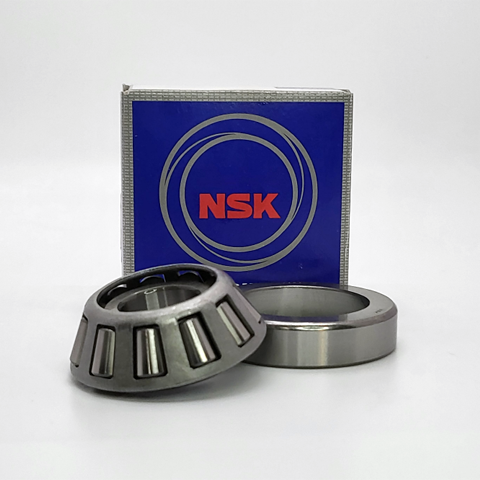
NSK NSK Tapered Roller Bearings, Single-Row Metric Design HR32038XJ ,D=190
NSK Tapered Roller Bearings, Single-Row Metric Design HR32038XJ ,D=190 Bearing Numbers Boundary Dimensions (mm) Basic Load Ratings (kN) Limiting Speeds (min-1) ISO355 Dimensions Series approx. Constant e Axial Load Factors Mass (kg) approx. d D T B C Cone r min. Cup r min. Cr C0r Grease Oil Y1 Y0 HR32038XJ 190 290 64 64 48 3 2.5 650 1170 1100 1500 4FD 0.44 1.4 0.75 14.9 DESIGN, TYPES, AND FEATURES Tapered roller bearings are designed so the apices of the cones formed by the raceways of the inner and outer rings and the inner ring rollers all coincide at one point on the axis of the bearing. When a radial load is imposed, a component axial force occurs; therefore, it is necessary to use two bearings in opposition or some other multiple-bearing arrangement. For Metric Series medium-angle or steep-angle tapered roller bearings, the respective contact angle designation C or D is added after the bore number. For normal-angle tapered roller bearings, no contact angle designation is used. Medium-angle tapered roller bearings are primarily used for the pinion shafts of differential gears in automobiles. Some bearings with high load capacity (HR Series) contain a J suffix that indicates they conform to ISO specifications for outer ring back face raceway diameter, outer ring width, and contact angle. Therefore, the inner ring assembly and outer ring of bearings with a J suffix are internationally interchangeable. Some Metric Series tapered roller bearings specified by ISO 355 have different dimensions from past Series 3XX bearings. Some of these are listed in the bearing tables. These conform to ISO specifications for the small-end diameter of the inner ring and contact angle. The inner and outer ring assemblies are internationally interchangeable. The bearing designation structure, which has changed from the past, is listed below: Inch Series bearings also exist. Inner ring assemblies and outer rings are approximately formulated as follows (excluding four-row tapered roller bearings): Various arrangements of tapered roller bearings (excluding single-row bearings) are available. The cages of tapered roller bearings are usually made of pressed steel. Table 1 Design and Features of Tapered Roller Bearing Arrangements Design Arrangement Ex. Bearing Designation Features Back-to-back HR30210JDB+KLR10 Two standard bearings are combined. The bearing clearances are adjusted by inner ring spacers or outer ring spacers. The inner rings, outer rings, and spacers are marked with serial numbers and mating marks. Components with the same serial number can be assembled by referring to the matching indications. Face-to-face HR30210JDF+KR KBE Type 100KBE31+L The KBE type is a back-to-back arrangement of bearings with an integrated outer ring spacer. The KH type is a face-to-face arrangement in which the inner rings are integrated. Since the bearing clearance is adjusted using spacers, components must have the same serial number for assembly with reference to the matching indications. KH Type 110KH31+K
$1,668.76
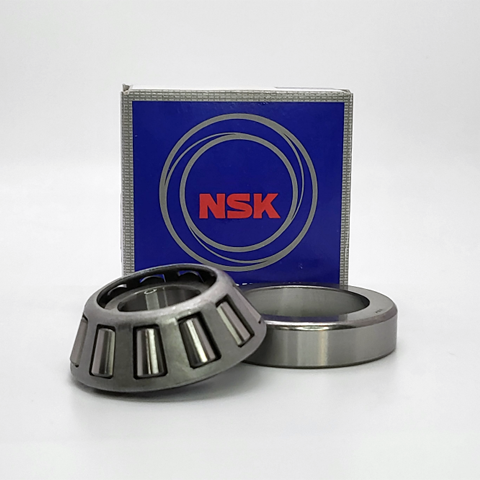
NSK NSK Tapered Roller Bearings, Single-Row Metric Design HR32036XJ ,D=180
NSK Tapered Roller Bearings, Single-Row Metric Design HR32036XJ ,D=180 Bearing Numbers Boundary Dimensions (mm) Basic Load Ratings (kN) Limiting Speeds (min-1) ISO355 Dimensions Series approx. Constant e Axial Load Factors Mass (kg) approx. d D T B C Cone r min. Cup r min. Cr C0r Grease Oil Y1 Y0 HR32036XJ 180 280 64 64 48 3 2.5 640 1130 1200 1600 3FD 0.42 1.4 0.78 14.3 DESIGN, TYPES, AND FEATURES Tapered roller bearings are designed so the apices of the cones formed by the raceways of the inner and outer rings and the inner ring rollers all coincide at one point on the axis of the bearing. When a radial load is imposed, a component axial force occurs; therefore, it is necessary to use two bearings in opposition or some other multiple-bearing arrangement. For Metric Series medium-angle or steep-angle tapered roller bearings, the respective contact angle designation C or D is added after the bore number. For normal-angle tapered roller bearings, no contact angle designation is used. Medium-angle tapered roller bearings are primarily used for the pinion shafts of differential gears in automobiles. Some bearings with high load capacity (HR Series) contain a J suffix that indicates they conform to ISO specifications for outer ring back face raceway diameter, outer ring width, and contact angle. Therefore, the inner ring assembly and outer ring of bearings with a J suffix are internationally interchangeable. Some Metric Series tapered roller bearings specified by ISO 355 have different dimensions from past Series 3XX bearings. Some of these are listed in the bearing tables. These conform to ISO specifications for the small-end diameter of the inner ring and contact angle. The inner and outer ring assemblies are internationally interchangeable. The bearing designation structure, which has changed from the past, is listed below: Inch Series bearings also exist. Inner ring assemblies and outer rings are approximately formulated as follows (excluding four-row tapered roller bearings): Various arrangements of tapered roller bearings (excluding single-row bearings) are available. The cages of tapered roller bearings are usually made of pressed steel. Table 1 Design and Features of Tapered Roller Bearing Arrangements Design Arrangement Ex. Bearing Designation Features Back-to-back HR30210JDB+KLR10 Two standard bearings are combined. The bearing clearances are adjusted by inner ring spacers or outer ring spacers. The inner rings, outer rings, and spacers are marked with serial numbers and mating marks. Components with the same serial number can be assembled by referring to the matching indications. Face-to-face HR30210JDF+KR KBE Type 100KBE31+L The KBE type is a back-to-back arrangement of bearings with an integrated outer ring spacer. The KH type is a face-to-face arrangement in which the inner rings are integrated. Since the bearing clearance is adjusted using spacers, components must have the same serial number for assembly with reference to the matching indications. KH Type 110KH31+K
$1,427.60
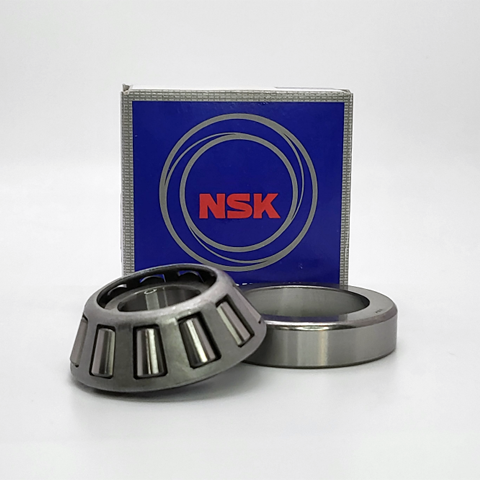
NSK NSK Tapered Roller Bearings, Single-Row Metric Design HR32034XJ ,D=170
NSK Tapered Roller Bearings, Single-Row Metric Design HR32034XJ ,D=170 Bearing Numbers Boundary Dimensions (mm) Basic Load Ratings (kN) Limiting Speeds (min-1) ISO355 Dimensions Series approx. Constant e Axial Load Factors Mass (kg) approx. d D T B C Cone r min. Cup r min. Cr C0r Grease Oil Y1 Y0 HR32034XJ 170 260 57 57 43 3 2.5 505 890 1200 1700 4EC 0.44 1.4 0.74 10.6 DESIGN, TYPES, AND FEATURES Tapered roller bearings are designed so the apices of the cones formed by the raceways of the inner and outer rings and the inner ring rollers all coincide at one point on the axis of the bearing. When a radial load is imposed, a component axial force occurs; therefore, it is necessary to use two bearings in opposition or some other multiple-bearing arrangement. For Metric Series medium-angle or steep-angle tapered roller bearings, the respective contact angle designation C or D is added after the bore number. For normal-angle tapered roller bearings, no contact angle designation is used. Medium-angle tapered roller bearings are primarily used for the pinion shafts of differential gears in automobiles. Some bearings with high load capacity (HR Series) contain a J suffix that indicates they conform to ISO specifications for outer ring back face raceway diameter, outer ring width, and contact angle. Therefore, the inner ring assembly and outer ring of bearings with a J suffix are internationally interchangeable. Some Metric Series tapered roller bearings specified by ISO 355 have different dimensions from past Series 3XX bearings. Some of these are listed in the bearing tables. These conform to ISO specifications for the small-end diameter of the inner ring and contact angle. The inner and outer ring assemblies are internationally interchangeable. The bearing designation structure, which has changed from the past, is listed below: Inch Series bearings also exist. Inner ring assemblies and outer rings are approximately formulated as follows (excluding four-row tapered roller bearings): Various arrangements of tapered roller bearings (excluding single-row bearings) are available. The cages of tapered roller bearings are usually made of pressed steel. Table 1 Design and Features of Tapered Roller Bearing Arrangements Design Arrangement Ex. Bearing Designation Features Back-to-back HR30210JDB+KLR10 Two standard bearings are combined. The bearing clearances are adjusted by inner ring spacers or outer ring spacers. The inner rings, outer rings, and spacers are marked with serial numbers and mating marks. Components with the same serial number can be assembled by referring to the matching indications. Face-to-face HR30210JDF+KR KBE Type 100KBE31+L The KBE type is a back-to-back arrangement of bearings with an integrated outer ring spacer. The KH type is a face-to-face arrangement in which the inner rings are integrated. Since the bearing clearance is adjusted using spacers, components must have the same serial number for assembly with reference to the matching indications. KH Type 110KH31+K
$1,233.66
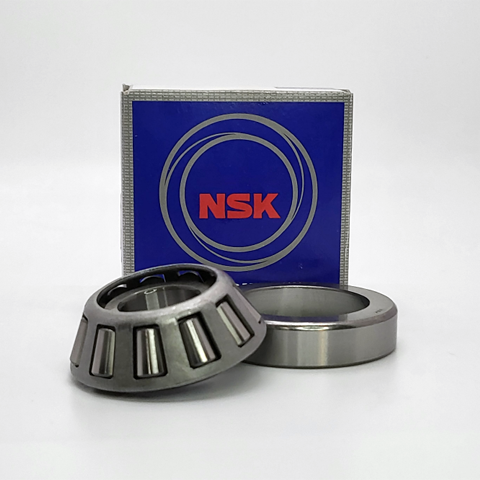
NSK NSK Tapered Roller Bearings, Single-Row Metric Design HR32032XJ ,D=160
NSK Tapered Roller Bearings, Single-Row Metric Design HR32032XJ ,D=160 Bearing Numbers Boundary Dimensions (mm) Basic Load Ratings (kN) Limiting Speeds (min-1) ISO355 Dimensions Series approx. Constant e Axial Load Factors Mass (kg) approx. d D T B C Cone r min. Cup r min. Cr C0r Grease Oil Y1 Y0 HR32032XJ 160 240 51 51 38 3 2.5 425 750 1300 1800 4EC 0.46 1.3 0.72 7.93 DESIGN, TYPES, AND FEATURES Tapered roller bearings are designed so the apices of the cones formed by the raceways of the inner and outer rings and the inner ring rollers all coincide at one point on the axis of the bearing. When a radial load is imposed, a component axial force occurs; therefore, it is necessary to use two bearings in opposition or some other multiple-bearing arrangement. For Metric Series medium-angle or steep-angle tapered roller bearings, the respective contact angle designation C or D is added after the bore number. For normal-angle tapered roller bearings, no contact angle designation is used. Medium-angle tapered roller bearings are primarily used for the pinion shafts of differential gears in automobiles. Some bearings with high load capacity (HR Series) contain a J suffix that indicates they conform to ISO specifications for outer ring back face raceway diameter, outer ring width, and contact angle. Therefore, the inner ring assembly and outer ring of bearings with a J suffix are internationally interchangeable. Some Metric Series tapered roller bearings specified by ISO 355 have different dimensions from past Series 3XX bearings. Some of these are listed in the bearing tables. These conform to ISO specifications for the small-end diameter of the inner ring and contact angle. The inner and outer ring assemblies are internationally interchangeable. The bearing designation structure, which has changed from the past, is listed below: Inch Series bearings also exist. Inner ring assemblies and outer rings are approximately formulated as follows (excluding four-row tapered roller bearings): Various arrangements of tapered roller bearings (excluding single-row bearings) are available. The cages of tapered roller bearings are usually made of pressed steel. Table 1 Design and Features of Tapered Roller Bearing Arrangements Design Arrangement Ex. Bearing Designation Features Back-to-back HR30210JDB+KLR10 Two standard bearings are combined. The bearing clearances are adjusted by inner ring spacers or outer ring spacers. The inner rings, outer rings, and spacers are marked with serial numbers and mating marks. Components with the same serial number can be assembled by referring to the matching indications. Face-to-face HR30210JDF+KR KBE Type 100KBE31+L The KBE type is a back-to-back arrangement of bearings with an integrated outer ring spacer. The KH type is a face-to-face arrangement in which the inner rings are integrated. Since the bearing clearance is adjusted using spacers, components must have the same serial number for assembly with reference to the matching indications. KH Type 110KH31+K
$1,000.00
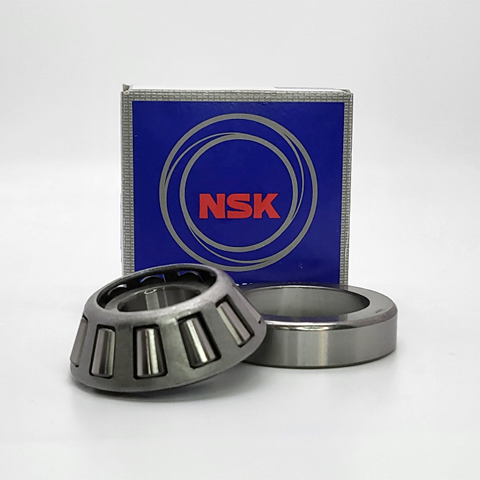
NSK NSK Tapered Roller Bearings, Single-Row Metric Design HR32030XJ ,D=150
NSK Tapered Roller Bearings, Single-Row Metric Design HR32030XJ ,D=150 Bearing Numbers Boundary Dimensions (mm) Basic Load Ratings (kN) Limiting Speeds (min-1) ISO355 Dimensions Series approx. Constant e Axial Load Factors Mass (kg) approx. d D T B C Cone r min. Cup r min. Cr C0r Grease Oil Y1 Y0 HR32030XJ 150 225 48 48 36 3 2.5 375 650 1400 2000 4EC 0.46 1.3 0.72 6.6 DESIGN, TYPES, AND FEATURES Tapered roller bearings are designed so the apices of the cones formed by the raceways of the inner and outer rings and the inner ring rollers all coincide at one point on the axis of the bearing. When a radial load is imposed, a component axial force occurs; therefore, it is necessary to use two bearings in opposition or some other multiple-bearing arrangement. For Metric Series medium-angle or steep-angle tapered roller bearings, the respective contact angle designation C or D is added after the bore number. For normal-angle tapered roller bearings, no contact angle designation is used. Medium-angle tapered roller bearings are primarily used for the pinion shafts of differential gears in automobiles. Some bearings with high load capacity (HR Series) contain a J suffix that indicates they conform to ISO specifications for outer ring back face raceway diameter, outer ring width, and contact angle. Therefore, the inner ring assembly and outer ring of bearings with a J suffix are internationally interchangeable. Some Metric Series tapered roller bearings specified by ISO 355 have different dimensions from past Series 3XX bearings. Some of these are listed in the bearing tables. These conform to ISO specifications for the small-end diameter of the inner ring and contact angle. The inner and outer ring assemblies are internationally interchangeable. The bearing designation structure, which has changed from the past, is listed below: Inch Series bearings also exist. Inner ring assemblies and outer rings are approximately formulated as follows (excluding four-row tapered roller bearings): Various arrangements of tapered roller bearings (excluding single-row bearings) are available. The cages of tapered roller bearings are usually made of pressed steel. Table 1 Design and Features of Tapered Roller Bearing Arrangements Design Arrangement Ex. Bearing Designation Features Back-to-back HR30210JDB+KLR10 Two standard bearings are combined. The bearing clearances are adjusted by inner ring spacers or outer ring spacers. The inner rings, outer rings, and spacers are marked with serial numbers and mating marks. Components with the same serial number can be assembled by referring to the matching indications. Face-to-face HR30210JDF+KR KBE Type 100KBE31+L The KBE type is a back-to-back arrangement of bearings with an integrated outer ring spacer. The KH type is a face-to-face arrangement in which the inner rings are integrated. Since the bearing clearance is adjusted using spacers, components must have the same serial number for assembly with reference to the matching indications. KH Type 110KH31+K
$881.32
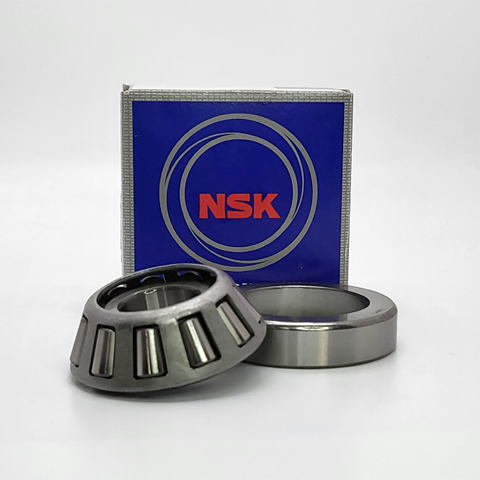
NSK NSK Tapered Roller Bearings, Single-Row Metric Design HR32028XJ ,D=140
NSK Tapered Roller Bearings, Single-Row Metric Design HR32028XJ ,D=140 Bearing Numbers Boundary Dimensions (mm) Basic Load Ratings (kN) Limiting Speeds (min-1) ISO355 Dimensions Series approx. Constant e Axial Load Factors Mass (kg) approx. d D T B C Cone r min. Cup r min. Cr C0r Grease Oil Y1 Y0 HR32028XJ 140 210 45 45 34 2.5 2 325 555 1600 2200 4DC 0.46 1.3 0.72 5.32 DESIGN, TYPES, AND FEATURES Tapered roller bearings are designed so the apices of the cones formed by the raceways of the inner and outer rings and the inner ring rollers all coincide at one point on the axis of the bearing. When a radial load is imposed, a component axial force occurs; therefore, it is necessary to use two bearings in opposition or some other multiple-bearing arrangement. For Metric Series medium-angle or steep-angle tapered roller bearings, the respective contact angle designation C or D is added after the bore number. For normal-angle tapered roller bearings, no contact angle designation is used. Medium-angle tapered roller bearings are primarily used for the pinion shafts of differential gears in automobiles. Some bearings with high load capacity (HR Series) contain a J suffix that indicates they conform to ISO specifications for outer ring back face raceway diameter, outer ring width, and contact angle. Therefore, the inner ring assembly and outer ring of bearings with a J suffix are internationally interchangeable. Some Metric Series tapered roller bearings specified by ISO 355 have different dimensions from past Series 3XX bearings. Some of these are listed in the bearing tables. These conform to ISO specifications for the small-end diameter of the inner ring and contact angle. The inner and outer ring assemblies are internationally interchangeable. The bearing designation structure, which has changed from the past, is listed below: Inch Series bearings also exist. Inner ring assemblies and outer rings are approximately formulated as follows (excluding four-row tapered roller bearings): Various arrangements of tapered roller bearings (excluding single-row bearings) are available. The cages of tapered roller bearings are usually made of pressed steel. Table 1 Design and Features of Tapered Roller Bearing Arrangements Design Arrangement Ex. Bearing Designation Features Back-to-back HR30210JDB+KLR10 Two standard bearings are combined. The bearing clearances are adjusted by inner ring spacers or outer ring spacers. The inner rings, outer rings, and spacers are marked with serial numbers and mating marks. Components with the same serial number can be assembled by referring to the matching indications. Face-to-face HR30210JDF+KR KBE Type 100KBE31+L The KBE type is a back-to-back arrangement of bearings with an integrated outer ring spacer. The KH type is a face-to-face arrangement in which the inner rings are integrated. Since the bearing clearance is adjusted using spacers, components must have the same serial number for assembly with reference to the matching indications. KH Type 110KH31+K
$684.62
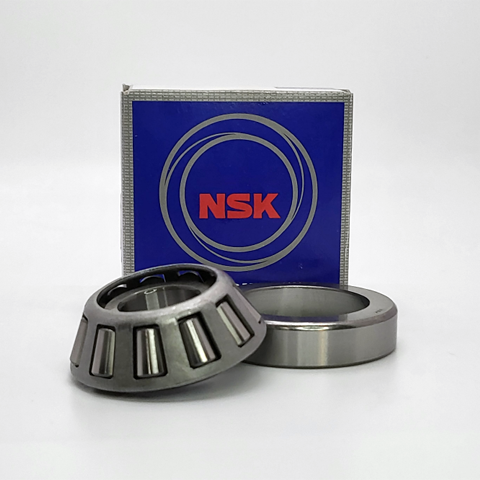
NSK NSK Tapered Roller Bearings, Single-Row Metric Design HR32026XJ ,D=130
NSK Tapered Roller Bearings, Single-Row Metric Design HR32026XJ ,D=130 Bearing Numbers Boundary Dimensions (mm) Basic Load Ratings (kN) Limiting Speeds (min-1) ISO355 Dimensions Series approx. Constant e Axial Load Factors Mass (kg) approx. d D T B C Cone r min. Cup r min. Cr C0r Grease Oil Y1 Y0 HR32026XJ 130 200 45 45 34 2.5 2 320 535 1600 2200 4EC 0.43 1.4 0.76 5.06 DESIGN, TYPES, AND FEATURES Tapered roller bearings are designed so the apices of the cones formed by the raceways of the inner and outer rings and the inner ring rollers all coincide at one point on the axis of the bearing. When a radial load is imposed, a component axial force occurs; therefore, it is necessary to use two bearings in opposition or some other multiple-bearing arrangement. For Metric Series medium-angle or steep-angle tapered roller bearings, the respective contact angle designation C or D is added after the bore number. For normal-angle tapered roller bearings, no contact angle designation is used. Medium-angle tapered roller bearings are primarily used for the pinion shafts of differential gears in automobiles. Some bearings with high load capacity (HR Series) contain a J suffix that indicates they conform to ISO specifications for outer ring back face raceway diameter, outer ring width, and contact angle. Therefore, the inner ring assembly and outer ring of bearings with a J suffix are internationally interchangeable. Some Metric Series tapered roller bearings specified by ISO 355 have different dimensions from past Series 3XX bearings. Some of these are listed in the bearing tables. These conform to ISO specifications for the small-end diameter of the inner ring and contact angle. The inner and outer ring assemblies are internationally interchangeable. The bearing designation structure, which has changed from the past, is listed below: Inch Series bearings also exist. Inner ring assemblies and outer rings are approximately formulated as follows (excluding four-row tapered roller bearings): Various arrangements of tapered roller bearings (excluding single-row bearings) are available. The cages of tapered roller bearings are usually made of pressed steel. Table 1 Design and Features of Tapered Roller Bearing Arrangements Design Arrangement Ex. Bearing Designation Features Back-to-back HR30210JDB+KLR10 Two standard bearings are combined. The bearing clearances are adjusted by inner ring spacers or outer ring spacers. The inner rings, outer rings, and spacers are marked with serial numbers and mating marks. Components with the same serial number can be assembled by referring to the matching indications. Face-to-face HR30210JDF+KR KBE Type 100KBE31+L The KBE type is a back-to-back arrangement of bearings with an integrated outer ring spacer. The KH type is a face-to-face arrangement in which the inner rings are integrated. Since the bearing clearance is adjusted using spacers, components must have the same serial number for assembly with reference to the matching indications. KH Type 110KH31+K
$482.38
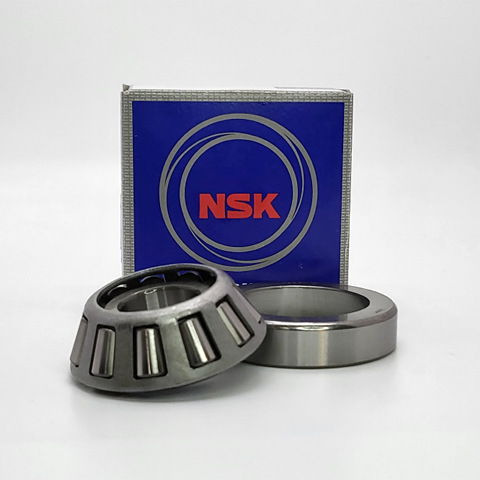
NSK NSK Tapered Roller Bearings, Single-Row Metric Design HR32024XJ ,D=120
NSK Tapered Roller Bearings, Single-Row Metric Design HR32024XJ ,D=120 Bearing Numbers Boundary Dimensions (mm) Basic Load Ratings (kN) Limiting Speeds (min-1) ISO355 Dimensions Series approx. Constant e Axial Load Factors Mass (kg) approx. d D T B C Cone r min. Cup r min. Cr C0r Grease Oil Y1 Y0 HR32024XJ 120 180 38 38 29 2.5 2 242 405 1800 2400 4DC 0.46 1.3 0.72 3.27 DESIGN, TYPES, AND FEATURES Tapered roller bearings are designed so the apices of the cones formed by the raceways of the inner and outer rings and the inner ring rollers all coincide at one point on the axis of the bearing. When a radial load is imposed, a component axial force occurs; therefore, it is necessary to use two bearings in opposition or some other multiple-bearing arrangement. For Metric Series medium-angle or steep-angle tapered roller bearings, the respective contact angle designation C or D is added after the bore number. For normal-angle tapered roller bearings, no contact angle designation is used. Medium-angle tapered roller bearings are primarily used for the pinion shafts of differential gears in automobiles. Some bearings with high load capacity (HR Series) contain a J suffix that indicates they conform to ISO specifications for outer ring back face raceway diameter, outer ring width, and contact angle. Therefore, the inner ring assembly and outer ring of bearings with a J suffix are internationally interchangeable. Some Metric Series tapered roller bearings specified by ISO 355 have different dimensions from past Series 3XX bearings. Some of these are listed in the bearing tables. These conform to ISO specifications for the small-end diameter of the inner ring and contact angle. The inner and outer ring assemblies are internationally interchangeable. The bearing designation structure, which has changed from the past, is listed below: Inch Series bearings also exist. Inner ring assemblies and outer rings are approximately formulated as follows (excluding four-row tapered roller bearings): Various arrangements of tapered roller bearings (excluding single-row bearings) are available. The cages of tapered roller bearings are usually made of pressed steel. Table 1 Design and Features of Tapered Roller Bearing Arrangements Design Arrangement Ex. Bearing Designation Features Back-to-back HR30210JDB+KLR10 Two standard bearings are combined. The bearing clearances are adjusted by inner ring spacers or outer ring spacers. The inner rings, outer rings, and spacers are marked with serial numbers and mating marks. Components with the same serial number can be assembled by referring to the matching indications. Face-to-face HR30210JDF+KR KBE Type 100KBE31+L The KBE type is a back-to-back arrangement of bearings with an integrated outer ring spacer. The KH type is a face-to-face arrangement in which the inner rings are integrated. Since the bearing clearance is adjusted using spacers, components must have the same serial number for assembly with reference to the matching indications. KH Type 110KH31+K
$373.82
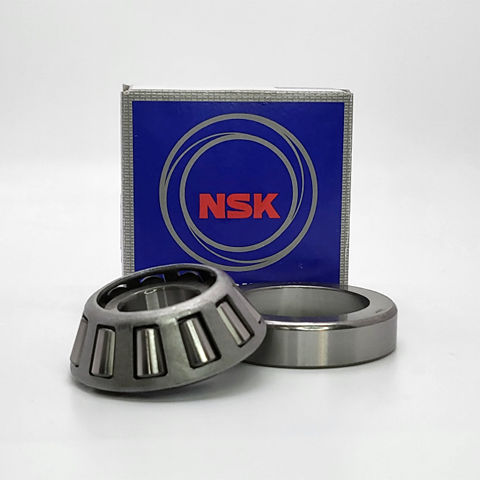
NSK NSK Tapered Roller Bearings, Single-Row Metric Design HR32022XJ ,D=110
NSK Tapered Roller Bearings, Single-Row Metric Design HR32022XJ ,D=110 Bearing Numbers Boundary Dimensions (mm) Basic Load Ratings (kN) Limiting Speeds (min-1) ISO355 Dimensions Series approx. Constant e Axial Load Factors Mass (kg) approx. d D T B C Cone r min. Cup r min. Cr C0r Grease Oil Y1 Y0 HR32022XJ 110 170 38 38 29 2.5 2 236 390 2000 2600 4DC 0.43 1.4 0.77 3.09 DESIGN, TYPES, AND FEATURES Tapered roller bearings are designed so the apices of the cones formed by the raceways of the inner and outer rings and the inner ring rollers all coincide at one point on the axis of the bearing. When a radial load is imposed, a component axial force occurs; therefore, it is necessary to use two bearings in opposition or some other multiple-bearing arrangement. For Metric Series medium-angle or steep-angle tapered roller bearings, the respective contact angle designation C or D is added after the bore number. For normal-angle tapered roller bearings, no contact angle designation is used. Medium-angle tapered roller bearings are primarily used for the pinion shafts of differential gears in automobiles. Some bearings with high load capacity (HR Series) contain a J suffix that indicates they conform to ISO specifications for outer ring back face raceway diameter, outer ring width, and contact angle. Therefore, the inner ring assembly and outer ring of bearings with a J suffix are internationally interchangeable. Some Metric Series tapered roller bearings specified by ISO 355 have different dimensions from past Series 3XX bearings. Some of these are listed in the bearing tables. These conform to ISO specifications for the small-end diameter of the inner ring and contact angle. The inner and outer ring assemblies are internationally interchangeable. The bearing designation structure, which has changed from the past, is listed below: Inch Series bearings also exist. Inner ring assemblies and outer rings are approximately formulated as follows (excluding four-row tapered roller bearings): Various arrangements of tapered roller bearings (excluding single-row bearings) are available. The cages of tapered roller bearings are usually made of pressed steel. Table 1 Design and Features of Tapered Roller Bearing Arrangements Design Arrangement Ex. Bearing Designation Features Back-to-back HR30210JDB+KLR10 Two standard bearings are combined. The bearing clearances are adjusted by inner ring spacers or outer ring spacers. The inner rings, outer rings, and spacers are marked with serial numbers and mating marks. Components with the same serial number can be assembled by referring to the matching indications. Face-to-face HR30210JDF+KR KBE Type 100KBE31+L The KBE type is a back-to-back arrangement of bearings with an integrated outer ring spacer. The KH type is a face-to-face arrangement in which the inner rings are integrated. Since the bearing clearance is adjusted using spacers, components must have the same serial number for assembly with reference to the matching indications. KH Type 110KH31+K
$277.30
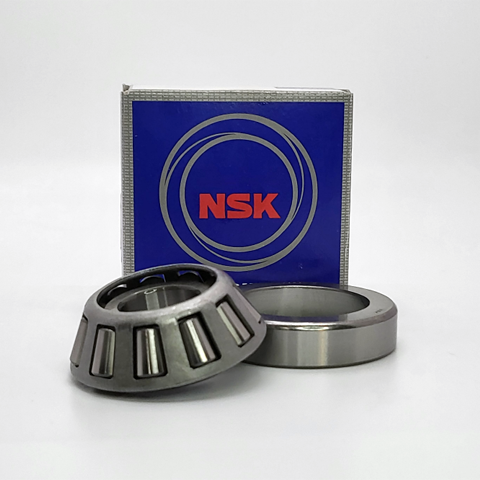
NSK NSK Tapered Roller Bearings, Single-Row Metric Design HR32021XJ ,D=105
NSK Tapered Roller Bearings, Single-Row Metric Design HR32021XJ ,D=105 Bearing Numbers Boundary Dimensions (mm) Basic Load Ratings (kN) Limiting Speeds (min-1) ISO355 Dimensions Series approx. Constant e Axial Load Factors Mass (kg) approx. d D T B C Cone r min. Cup r min. Cr C0r Grease Oil Y1 Y0 HR32021XJ 105 160 35 35 26 2.5 2 204 340 2000 2800 4DC 0.44 1.4 0.74 2.48 DESIGN, TYPES, AND FEATURES Tapered roller bearings are designed so the apices of the cones formed by the raceways of the inner and outer rings and the inner ring rollers all coincide at one point on the axis of the bearing. When a radial load is imposed, a component axial force occurs; therefore, it is necessary to use two bearings in opposition or some other multiple-bearing arrangement. For Metric Series medium-angle or steep-angle tapered roller bearings, the respective contact angle designation C or D is added after the bore number. For normal-angle tapered roller bearings, no contact angle designation is used. Medium-angle tapered roller bearings are primarily used for the pinion shafts of differential gears in automobiles. Some bearings with high load capacity (HR Series) contain a J suffix that indicates they conform to ISO specifications for outer ring back face raceway diameter, outer ring width, and contact angle. Therefore, the inner ring assembly and outer ring of bearings with a J suffix are internationally interchangeable. Some Metric Series tapered roller bearings specified by ISO 355 have different dimensions from past Series 3XX bearings. Some of these are listed in the bearing tables. These conform to ISO specifications for the small-end diameter of the inner ring and contact angle. The inner and outer ring assemblies are internationally interchangeable. The bearing designation structure, which has changed from the past, is listed below: Inch Series bearings also exist. Inner ring assemblies and outer rings are approximately formulated as follows (excluding four-row tapered roller bearings): Various arrangements of tapered roller bearings (excluding single-row bearings) are available. The cages of tapered roller bearings are usually made of pressed steel. Table 1 Design and Features of Tapered Roller Bearing Arrangements Design Arrangement Ex. Bearing Designation Features Back-to-back HR30210JDB+KLR10 Two standard bearings are combined. The bearing clearances are adjusted by inner ring spacers or outer ring spacers. The inner rings, outer rings, and spacers are marked with serial numbers and mating marks. Components with the same serial number can be assembled by referring to the matching indications. Face-to-face HR30210JDF+KR KBE Type 100KBE31+L The KBE type is a back-to-back arrangement of bearings with an integrated outer ring spacer. The KH type is a face-to-face arrangement in which the inner rings are integrated. Since the bearing clearance is adjusted using spacers, components must have the same serial number for assembly with reference to the matching indications. KH Type 110KH31+K
$233.90
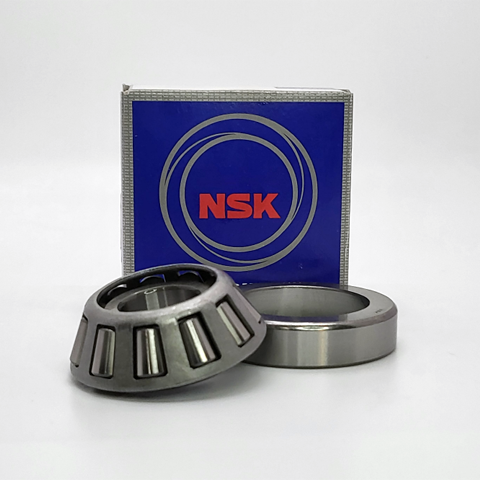
NSK NSK Tapered Roller Bearings, Single-Row Metric Design HR32020XJ ,D=100
NSK Tapered Roller Bearings, Single-Row Metric Design HR32020XJ ,D=100 Bearing Numbers Boundary Dimensions (mm) Basic Load Ratings (kN) Limiting Speeds (min-1) ISO355 Dimensions Series approx. Constant e Axial Load Factors Mass (kg) approx. d D T B C Cone r min. Cup r min. Cr C0r Grease Oil Y1 Y0 HR32020XJ 100 150 32 32 24 2 1.5 176 294 2200 3000 4CC 0.46 1.3 0.72 1.95 DESIGN, TYPES, AND FEATURES Tapered roller bearings are designed so the apices of the cones formed by the raceways of the inner and outer rings and the inner ring rollers all coincide at one point on the axis of the bearing. When a radial load is imposed, a component axial force occurs; therefore, it is necessary to use two bearings in opposition or some other multiple-bearing arrangement. For Metric Series medium-angle or steep-angle tapered roller bearings, the respective contact angle designation C or D is added after the bore number. For normal-angle tapered roller bearings, no contact angle designation is used. Medium-angle tapered roller bearings are primarily used for the pinion shafts of differential gears in automobiles. Some bearings with high load capacity (HR Series) contain a J suffix that indicates they conform to ISO specifications for outer ring back face raceway diameter, outer ring width, and contact angle. Therefore, the inner ring assembly and outer ring of bearings with a J suffix are internationally interchangeable. Some Metric Series tapered roller bearings specified by ISO 355 have different dimensions from past Series 3XX bearings. Some of these are listed in the bearing tables. These conform to ISO specifications for the small-end diameter of the inner ring and contact angle. The inner and outer ring assemblies are internationally interchangeable. The bearing designation structure, which has changed from the past, is listed below: Inch Series bearings also exist. Inner ring assemblies and outer rings are approximately formulated as follows (excluding four-row tapered roller bearings): Various arrangements of tapered roller bearings (excluding single-row bearings) are available. The cages of tapered roller bearings are usually made of pressed steel. Table 1 Design and Features of Tapered Roller Bearing Arrangements Design Arrangement Ex. Bearing Designation Features Back-to-back HR30210JDB+KLR10 Two standard bearings are combined. The bearing clearances are adjusted by inner ring spacers or outer ring spacers. The inner rings, outer rings, and spacers are marked with serial numbers and mating marks. Components with the same serial number can be assembled by referring to the matching indications. Face-to-face HR30210JDF+KR KBE Type 100KBE31+L The KBE type is a back-to-back arrangement of bearings with an integrated outer ring spacer. The KH type is a face-to-face arrangement in which the inner rings are integrated. Since the bearing clearance is adjusted using spacers, components must have the same serial number for assembly with reference to the matching indications. KH Type 110KH31+K
$186.88
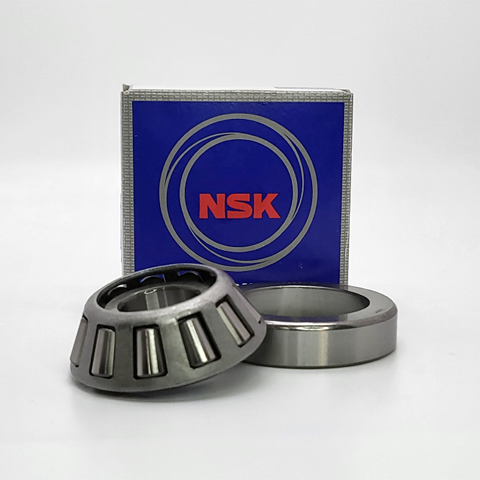
NSK NSK Tapered Roller Bearings, Single-Row Metric Design HR32019XJ ,D=95
NSK Tapered Roller Bearings, Single-Row Metric Design HR32019XJ ,D=95 Bearing Numbers Boundary Dimensions (mm) Basic Load Ratings (kN) Limiting Speeds (min-1) ISO355 Dimensions Series approx. Constant e Axial Load Factors Mass (kg) approx. d D T B C Cone r min. Cup r min. Cr C0r Grease Oil Y1 Y0 HR32019XJ 95 145 32 32 24 2 1.5 173 283 2400 3200 4CC 0.44 1.4 0.75 1.88 DESIGN, TYPES, AND FEATURES Tapered roller bearings are designed so the apices of the cones formed by the raceways of the inner and outer rings and the inner ring rollers all coincide at one point on the axis of the bearing. When a radial load is imposed, a component axial force occurs; therefore, it is necessary to use two bearings in opposition or some other multiple-bearing arrangement. For Metric Series medium-angle or steep-angle tapered roller bearings, the respective contact angle designation C or D is added after the bore number. For normal-angle tapered roller bearings, no contact angle designation is used. Medium-angle tapered roller bearings are primarily used for the pinion shafts of differential gears in automobiles. Some bearings with high load capacity (HR Series) contain a J suffix that indicates they conform to ISO specifications for outer ring back face raceway diameter, outer ring width, and contact angle. Therefore, the inner ring assembly and outer ring of bearings with a J suffix are internationally interchangeable. Some Metric Series tapered roller bearings specified by ISO 355 have different dimensions from past Series 3XX bearings. Some of these are listed in the bearing tables. These conform to ISO specifications for the small-end diameter of the inner ring and contact angle. The inner and outer ring assemblies are internationally interchangeable. The bearing designation structure, which has changed from the past, is listed below: Inch Series bearings also exist. Inner ring assemblies and outer rings are approximately formulated as follows (excluding four-row tapered roller bearings): Various arrangements of tapered roller bearings (excluding single-row bearings) are available. The cages of tapered roller bearings are usually made of pressed steel. Table 1 Design and Features of Tapered Roller Bearing Arrangements Design Arrangement Ex. Bearing Designation Features Back-to-back HR30210JDB+KLR10 Two standard bearings are combined. The bearing clearances are adjusted by inner ring spacers or outer ring spacers. The inner rings, outer rings, and spacers are marked with serial numbers and mating marks. Components with the same serial number can be assembled by referring to the matching indications. Face-to-face HR30210JDF+KR KBE Type 100KBE31+L The KBE type is a back-to-back arrangement of bearings with an integrated outer ring spacer. The KH type is a face-to-face arrangement in which the inner rings are integrated. Since the bearing clearance is adjusted using spacers, components must have the same serial number for assembly with reference to the matching indications. KH Type 110KH31+K
$157.20
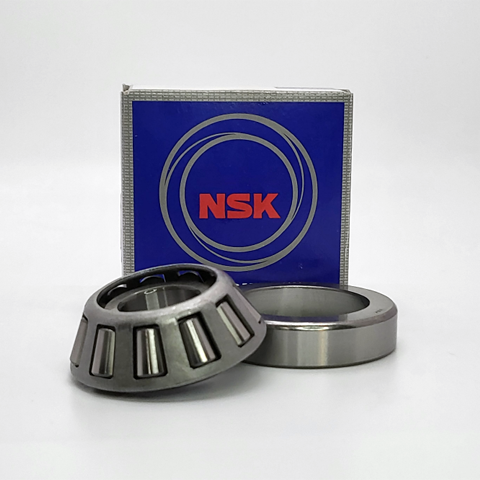
NSK NSK Tapered Roller Bearings, Single-Row Metric Design HR32018XJ ,D=90
NSK Tapered Roller Bearings, Single-Row Metric Design HR32018XJ ,D=90 Bearing Numbers Boundary Dimensions (mm) Basic Load Ratings (kN) Limiting Speeds (min-1) ISO355 Dimensions Series approx. Constant e Axial Load Factors Mass (kg) approx. d D T B C Cone r min. Cup r min. Cr C0r Grease Oil Y1 Y0 HR32018XJ 90 140 32 32 24 2 1.5 170 273 2400 3200 3CC 0.42 1.4 0.78 1.78 DESIGN, TYPES, AND FEATURES Tapered roller bearings are designed so the apices of the cones formed by the raceways of the inner and outer rings and the inner ring rollers all coincide at one point on the axis of the bearing. When a radial load is imposed, a component axial force occurs; therefore, it is necessary to use two bearings in opposition or some other multiple-bearing arrangement. For Metric Series medium-angle or steep-angle tapered roller bearings, the respective contact angle designation C or D is added after the bore number. For normal-angle tapered roller bearings, no contact angle designation is used. Medium-angle tapered roller bearings are primarily used for the pinion shafts of differential gears in automobiles. Some bearings with high load capacity (HR Series) contain a J suffix that indicates they conform to ISO specifications for outer ring back face raceway diameter, outer ring width, and contact angle. Therefore, the inner ring assembly and outer ring of bearings with a J suffix are internationally interchangeable. Some Metric Series tapered roller bearings specified by ISO 355 have different dimensions from past Series 3XX bearings. Some of these are listed in the bearing tables. These conform to ISO specifications for the small-end diameter of the inner ring and contact angle. The inner and outer ring assemblies are internationally interchangeable. The bearing designation structure, which has changed from the past, is listed below: Inch Series bearings also exist. Inner ring assemblies and outer rings are approximately formulated as follows (excluding four-row tapered roller bearings): Various arrangements of tapered roller bearings (excluding single-row bearings) are available. The cages of tapered roller bearings are usually made of pressed steel. Table 1 Design and Features of Tapered Roller Bearing Arrangements Design Arrangement Ex. Bearing Designation Features Back-to-back HR30210JDB+KLR10 Two standard bearings are combined. The bearing clearances are adjusted by inner ring spacers or outer ring spacers. The inner rings, outer rings, and spacers are marked with serial numbers and mating marks. Components with the same serial number can be assembled by referring to the matching indications. Face-to-face HR30210JDF+KR KBE Type 100KBE31+L The KBE type is a back-to-back arrangement of bearings with an integrated outer ring spacer. The KH type is a face-to-face arrangement in which the inner rings are integrated. Since the bearing clearance is adjusted using spacers, components must have the same serial number for assembly with reference to the matching indications. KH Type 110KH31+K
$152.02
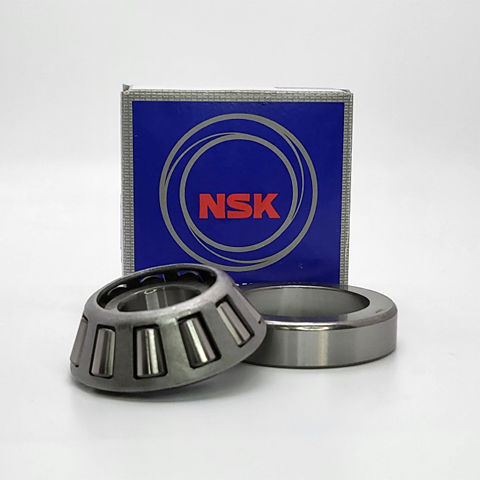
NSK NSK Tapered Roller Bearings, Single-Row Metric Design HR32017XJ ,D=85
NSK Tapered Roller Bearings, Single-Row Metric Design HR32017XJ ,D=85 Bearing Numbers Boundary Dimensions (mm) Basic Load Ratings (kN) Limiting Speeds (min-1) ISO355 Dimensions Series approx. Constant e Axial Load Factors Mass (kg) approx. d D T B C Cone r min. Cup r min. Cr C0r Grease Oil Y1 Y0 HR32017XJ 85 130 29 29 22 1.5 1.5 143 231 2600 3600 4CC 0.44 1.4 0.75 1.38 DESIGN, TYPES, AND FEATURES Tapered roller bearings are designed so the apices of the cones formed by the raceways of the inner and outer rings and the inner ring rollers all coincide at one point on the axis of the bearing. When a radial load is imposed, a component axial force occurs; therefore, it is necessary to use two bearings in opposition or some other multiple-bearing arrangement. For Metric Series medium-angle or steep-angle tapered roller bearings, the respective contact angle designation C or D is added after the bore number. For normal-angle tapered roller bearings, no contact angle designation is used. Medium-angle tapered roller bearings are primarily used for the pinion shafts of differential gears in automobiles. Some bearings with high load capacity (HR Series) contain a J suffix that indicates they conform to ISO specifications for outer ring back face raceway diameter, outer ring width, and contact angle. Therefore, the inner ring assembly and outer ring of bearings with a J suffix are internationally interchangeable. Some Metric Series tapered roller bearings specified by ISO 355 have different dimensions from past Series 3XX bearings. Some of these are listed in the bearing tables. These conform to ISO specifications for the small-end diameter of the inner ring and contact angle. The inner and outer ring assemblies are internationally interchangeable. The bearing designation structure, which has changed from the past, is listed below: Inch Series bearings also exist. Inner ring assemblies and outer rings are approximately formulated as follows (excluding four-row tapered roller bearings): Various arrangements of tapered roller bearings (excluding single-row bearings) are available. The cages of tapered roller bearings are usually made of pressed steel. Table 1 Design and Features of Tapered Roller Bearing Arrangements Design Arrangement Ex. Bearing Designation Features Back-to-back HR30210JDB+KLR10 Two standard bearings are combined. The bearing clearances are adjusted by inner ring spacers or outer ring spacers. The inner rings, outer rings, and spacers are marked with serial numbers and mating marks. Components with the same serial number can be assembled by referring to the matching indications. Face-to-face HR30210JDF+KR KBE Type 100KBE31+L The KBE type is a back-to-back arrangement of bearings with an integrated outer ring spacer. The KH type is a face-to-face arrangement in which the inner rings are integrated. Since the bearing clearance is adjusted using spacers, components must have the same serial number for assembly with reference to the matching indications. KH Type 110KH31+K
$133.08
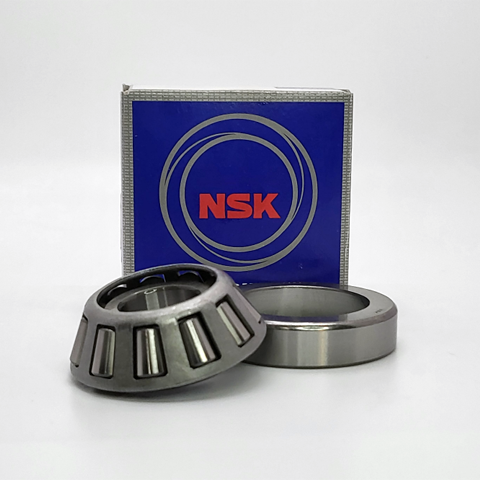
NSK NSK Tapered Roller Bearings, Single-Row Metric Design HR32016XJ ,D=80
NSK Tapered Roller Bearings, Single-Row Metric Design HR32016XJ ,D=80 Bearing Numbers Boundary Dimensions (mm) Basic Load Ratings (kN) Limiting Speeds (min-1) ISO355 Dimensions Series approx. Constant e Axial Load Factors Mass (kg) approx. d D T B C Cone r min. Cup r min. Cr C0r Grease Oil Y1 Y0 HR32016XJ 80 125 29 29 22 1.5 1.5 140 222 2800 3600 3CC 0.42 1.4 0.78 1.32 DESIGN, TYPES, AND FEATURES Tapered roller bearings are designed so the apices of the cones formed by the raceways of the inner and outer rings and the inner ring rollers all coincide at one point on the axis of the bearing. When a radial load is imposed, a component axial force occurs; therefore, it is necessary to use two bearings in opposition or some other multiple-bearing arrangement. For Metric Series medium-angle or steep-angle tapered roller bearings, the respective contact angle designation C or D is added after the bore number. For normal-angle tapered roller bearings, no contact angle designation is used. Medium-angle tapered roller bearings are primarily used for the pinion shafts of differential gears in automobiles. Some bearings with high load capacity (HR Series) contain a J suffix that indicates they conform to ISO specifications for outer ring back face raceway diameter, outer ring width, and contact angle. Therefore, the inner ring assembly and outer ring of bearings with a J suffix are internationally interchangeable. Some Metric Series tapered roller bearings specified by ISO 355 have different dimensions from past Series 3XX bearings. Some of these are listed in the bearing tables. These conform to ISO specifications for the small-end diameter of the inner ring and contact angle. The inner and outer ring assemblies are internationally interchangeable. The bearing designation structure, which has changed from the past, is listed below: Inch Series bearings also exist. Inner ring assemblies and outer rings are approximately formulated as follows (excluding four-row tapered roller bearings): Various arrangements of tapered roller bearings (excluding single-row bearings) are available. The cages of tapered roller bearings are usually made of pressed steel. Table 1 Design and Features of Tapered Roller Bearing Arrangements Design Arrangement Ex. Bearing Designation Features Back-to-back HR30210JDB+KLR10 Two standard bearings are combined. The bearing clearances are adjusted by inner ring spacers or outer ring spacers. The inner rings, outer rings, and spacers are marked with serial numbers and mating marks. Components with the same serial number can be assembled by referring to the matching indications. Face-to-face HR30210JDF+KR KBE Type 100KBE31+L The KBE type is a back-to-back arrangement of bearings with an integrated outer ring spacer. The KH type is a face-to-face arrangement in which the inner rings are integrated. Since the bearing clearance is adjusted using spacers, components must have the same serial number for assembly with reference to the matching indications. KH Type 110KH31+K
$114.30
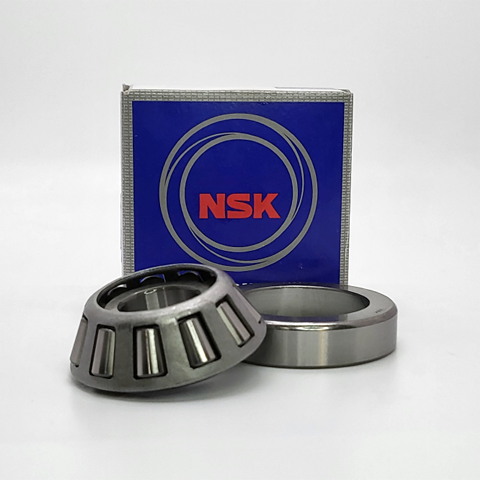
NSK NSK Tapered Roller Bearings, Single-Row Metric Design HR32015XJ ,D=75
NSK Tapered Roller Bearings, Single-Row Metric Design HR32015XJ ,D=75 Bearing Numbers Boundary Dimensions (mm) Basic Load Ratings (kN) Limiting Speeds (min-1) ISO355 Dimensions Series approx. Constant e Axial Load Factors Mass (kg) approx. d D T B C Cone r min. Cup r min. Cr C0r Grease Oil Y1 Y0 HR32015XJ 75 115 25 25 19 1.5 1.5 109 171 3000 4000 4CC 0.46 1.3 0.72 0.925 DESIGN, TYPES, AND FEATURES Tapered roller bearings are designed so the apices of the cones formed by the raceways of the inner and outer rings and the inner ring rollers all coincide at one point on the axis of the bearing. When a radial load is imposed, a component axial force occurs; therefore, it is necessary to use two bearings in opposition or some other multiple-bearing arrangement. For Metric Series medium-angle or steep-angle tapered roller bearings, the respective contact angle designation C or D is added after the bore number. For normal-angle tapered roller bearings, no contact angle designation is used. Medium-angle tapered roller bearings are primarily used for the pinion shafts of differential gears in automobiles. Some bearings with high load capacity (HR Series) contain a J suffix that indicates they conform to ISO specifications for outer ring back face raceway diameter, outer ring width, and contact angle. Therefore, the inner ring assembly and outer ring of bearings with a J suffix are internationally interchangeable. Some Metric Series tapered roller bearings specified by ISO 355 have different dimensions from past Series 3XX bearings. Some of these are listed in the bearing tables. These conform to ISO specifications for the small-end diameter of the inner ring and contact angle. The inner and outer ring assemblies are internationally interchangeable. The bearing designation structure, which has changed from the past, is listed below: Inch Series bearings also exist. Inner ring assemblies and outer rings are approximately formulated as follows (excluding four-row tapered roller bearings): Various arrangements of tapered roller bearings (excluding single-row bearings) are available. The cages of tapered roller bearings are usually made of pressed steel. Table 1 Design and Features of Tapered Roller Bearing Arrangements Design Arrangement Ex. Bearing Designation Features Back-to-back HR30210JDB+KLR10 Two standard bearings are combined. The bearing clearances are adjusted by inner ring spacers or outer ring spacers. The inner rings, outer rings, and spacers are marked with serial numbers and mating marks. Components with the same serial number can be assembled by referring to the matching indications. Face-to-face HR30210JDF+KR KBE Type 100KBE31+L The KBE type is a back-to-back arrangement of bearings with an integrated outer ring spacer. The KH type is a face-to-face arrangement in which the inner rings are integrated. Since the bearing clearance is adjusted using spacers, components must have the same serial number for assembly with reference to the matching indications. KH Type 110KH31+K
$84.48
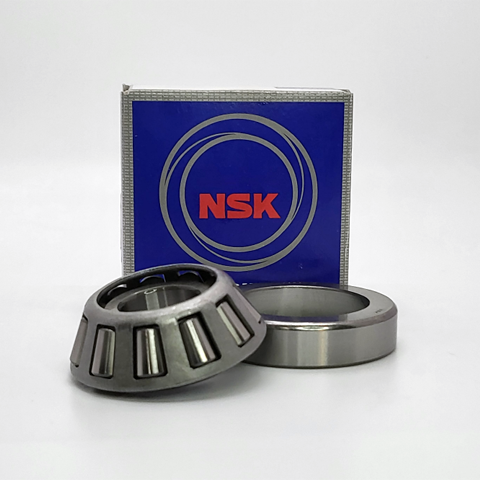
NSK NSK Tapered Roller Bearings, Single-Row Metric Design HR32014XJ ,D=70
NSK Tapered Roller Bearings, Single-Row Metric Design HR32014XJ ,D=70 Bearing Numbers Boundary Dimensions (mm) Basic Load Ratings (kN) Limiting Speeds (min-1) ISO355 Dimensions Series approx. Constant e Axial Load Factors Mass (kg) approx. d D T B C Cone r min. Cup r min. Cr C0r Grease Oil Y1 Y0 HR32014XJ 70 110 25 25 19 1.5 1.5 104 158 3200 4300 4CC 0.43 1.4 0.76 0.869 DESIGN, TYPES, AND FEATURES Tapered roller bearings are designed so the apices of the cones formed by the raceways of the inner and outer rings and the inner ring rollers all coincide at one point on the axis of the bearing. When a radial load is imposed, a component axial force occurs; therefore, it is necessary to use two bearings in opposition or some other multiple-bearing arrangement. For Metric Series medium-angle or steep-angle tapered roller bearings, the respective contact angle designation C or D is added after the bore number. For normal-angle tapered roller bearings, no contact angle designation is used. Medium-angle tapered roller bearings are primarily used for the pinion shafts of differential gears in automobiles. Some bearings with high load capacity (HR Series) contain a J suffix that indicates they conform to ISO specifications for outer ring back face raceway diameter, outer ring width, and contact angle. Therefore, the inner ring assembly and outer ring of bearings with a J suffix are internationally interchangeable. Some Metric Series tapered roller bearings specified by ISO 355 have different dimensions from past Series 3XX bearings. Some of these are listed in the bearing tables. These conform to ISO specifications for the small-end diameter of the inner ring and contact angle. The inner and outer ring assemblies are internationally interchangeable. The bearing designation structure, which has changed from the past, is listed below: Inch Series bearings also exist. Inner ring assemblies and outer rings are approximately formulated as follows (excluding four-row tapered roller bearings): Various arrangements of tapered roller bearings (excluding single-row bearings) are available. The cages of tapered roller bearings are usually made of pressed steel. Table 1 Design and Features of Tapered Roller Bearing Arrangements Design Arrangement Ex. Bearing Designation Features Back-to-back HR30210JDB+KLR10 Two standard bearings are combined. The bearing clearances are adjusted by inner ring spacers or outer ring spacers. The inner rings, outer rings, and spacers are marked with serial numbers and mating marks. Components with the same serial number can be assembled by referring to the matching indications. Face-to-face HR30210JDF+KR KBE Type 100KBE31+L The KBE type is a back-to-back arrangement of bearings with an integrated outer ring spacer. The KH type is a face-to-face arrangement in which the inner rings are integrated. Since the bearing clearance is adjusted using spacers, components must have the same serial number for assembly with reference to the matching indications. KH Type 110KH31+K
$78.68
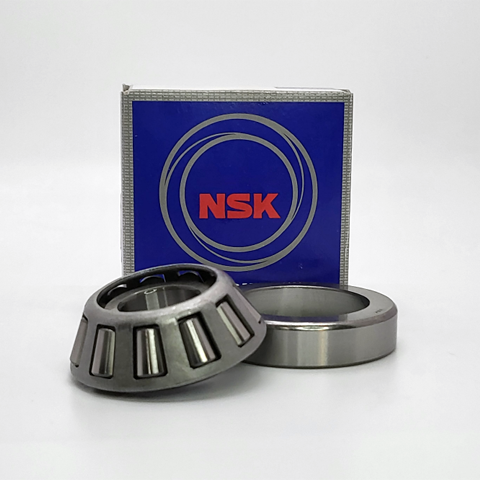
NSK NSK Tapered Roller Bearings, Single-Row Metric Design HR32013XJ ,D=65
NSK Tapered Roller Bearings, Single-Row Metric Design HR32013XJ ,D=65 Bearing Numbers Boundary Dimensions (mm) Basic Load Ratings (kN) Limiting Speeds (min-1) ISO355 Dimensions Series approx. Constant e Axial Load Factors Mass (kg) approx. d D T B C Cone r min. Cup r min. Cr C0r Grease Oil Y1 Y0 HR32013XJ 65 100 23 23 17.5 1.5 1.5 86.5 132 3400 4500 4CC 0.46 1.3 0.72 0.646 DESIGN, TYPES, AND FEATURES Tapered roller bearings are designed so the apices of the cones formed by the raceways of the inner and outer rings and the inner ring rollers all coincide at one point on the axis of the bearing. When a radial load is imposed, a component axial force occurs; therefore, it is necessary to use two bearings in opposition or some other multiple-bearing arrangement. For Metric Series medium-angle or steep-angle tapered roller bearings, the respective contact angle designation C or D is added after the bore number. For normal-angle tapered roller bearings, no contact angle designation is used. Medium-angle tapered roller bearings are primarily used for the pinion shafts of differential gears in automobiles. Some bearings with high load capacity (HR Series) contain a J suffix that indicates they conform to ISO specifications for outer ring back face raceway diameter, outer ring width, and contact angle. Therefore, the inner ring assembly and outer ring of bearings with a J suffix are internationally interchangeable. Some Metric Series tapered roller bearings specified by ISO 355 have different dimensions from past Series 3XX bearings. Some of these are listed in the bearing tables. These conform to ISO specifications for the small-end diameter of the inner ring and contact angle. The inner and outer ring assemblies are internationally interchangeable. The bearing designation structure, which has changed from the past, is listed below: Inch Series bearings also exist. Inner ring assemblies and outer rings are approximately formulated as follows (excluding four-row tapered roller bearings): Various arrangements of tapered roller bearings (excluding single-row bearings) are available. The cages of tapered roller bearings are usually made of pressed steel. Table 1 Design and Features of Tapered Roller Bearing Arrangements Design Arrangement Ex. Bearing Designation Features Back-to-back HR30210JDB+KLR10 Two standard bearings are combined. The bearing clearances are adjusted by inner ring spacers or outer ring spacers. The inner rings, outer rings, and spacers are marked with serial numbers and mating marks. Components with the same serial number can be assembled by referring to the matching indications. Face-to-face HR30210JDF+KR KBE Type 100KBE31+L The KBE type is a back-to-back arrangement of bearings with an integrated outer ring spacer. The KH type is a face-to-face arrangement in which the inner rings are integrated. Since the bearing clearance is adjusted using spacers, components must have the same serial number for assembly with reference to the matching indications. KH Type 110KH31+K
$66.66
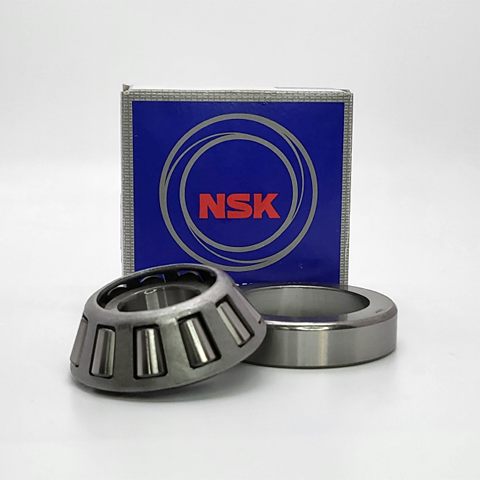
NSK NSK Tapered Roller Bearings, Single-Row Metric Design HR32012XJ ,D=60
NSK Tapered Roller Bearings, Single-Row Metric Design HR32012XJ ,D=60 Bearing Numbers Boundary Dimensions (mm) Basic Load Ratings (kN) Limiting Speeds (min-1) ISO355 Dimensions Series approx. Constant e Axial Load Factors Mass (kg) approx. d D T B C Cone r min. Cup r min. Cr C0r Grease Oil Y1 Y0 HR32012XJ 60 95 23 23 17.5 1.5 1.5 85.5 127 3600 5000 4CC 0.43 1.4 0.77 0.608 DESIGN, TYPES, AND FEATURES Tapered roller bearings are designed so the apices of the cones formed by the raceways of the inner and outer rings and the inner ring rollers all coincide at one point on the axis of the bearing. When a radial load is imposed, a component axial force occurs; therefore, it is necessary to use two bearings in opposition or some other multiple-bearing arrangement. For Metric Series medium-angle or steep-angle tapered roller bearings, the respective contact angle designation C or D is added after the bore number. For normal-angle tapered roller bearings, no contact angle designation is used. Medium-angle tapered roller bearings are primarily used for the pinion shafts of differential gears in automobiles. Some bearings with high load capacity (HR Series) contain a J suffix that indicates they conform to ISO specifications for outer ring back face raceway diameter, outer ring width, and contact angle. Therefore, the inner ring assembly and outer ring of bearings with a J suffix are internationally interchangeable. Some Metric Series tapered roller bearings specified by ISO 355 have different dimensions from past Series 3XX bearings. Some of these are listed in the bearing tables. These conform to ISO specifications for the small-end diameter of the inner ring and contact angle. The inner and outer ring assemblies are internationally interchangeable. The bearing designation structure, which has changed from the past, is listed below: Inch Series bearings also exist. Inner ring assemblies and outer rings are approximately formulated as follows (excluding four-row tapered roller bearings): Various arrangements of tapered roller bearings (excluding single-row bearings) are available. The cages of tapered roller bearings are usually made of pressed steel. Table 1 Design and Features of Tapered Roller Bearing Arrangements Design Arrangement Ex. Bearing Designation Features Back-to-back HR30210JDB+KLR10 Two standard bearings are combined. The bearing clearances are adjusted by inner ring spacers or outer ring spacers. The inner rings, outer rings, and spacers are marked with serial numbers and mating marks. Components with the same serial number can be assembled by referring to the matching indications. Face-to-face HR30210JDF+KR KBE Type 100KBE31+L The KBE type is a back-to-back arrangement of bearings with an integrated outer ring spacer. The KH type is a face-to-face arrangement in which the inner rings are integrated. Since the bearing clearance is adjusted using spacers, components must have the same serial number for assembly with reference to the matching indications. KH Type 110KH31+K
$62.84
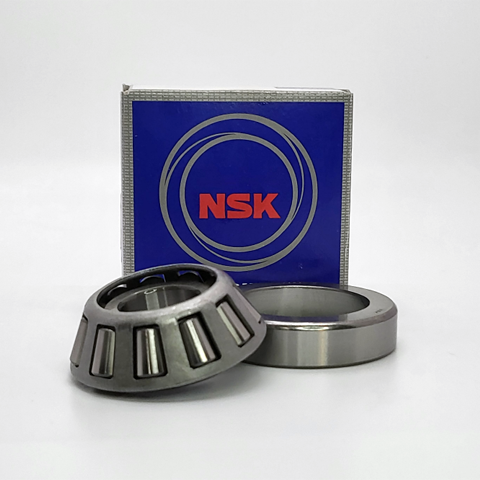
NSK NSK Tapered Roller Bearings, Single-Row Metric Design HR32011XJ ,D=55
NSK Tapered Roller Bearings, Single-Row Metric Design HR32011XJ ,D=55 Bearing Numbers Boundary Dimensions (mm) Basic Load Ratings (kN) Limiting Speeds (min-1) ISO355 Dimensions Series approx. Constant e Axial Load Factors Mass (kg) approx. d D T B C Cone r min. Cup r min. Cr C0r Grease Oil Y1 Y0 HR32011XJ 55 90 23 23 17.5 1.5 1.5 81.5 117 3800 5300 3CC 0.41 1.5 0.81 0.568 DESIGN, TYPES, AND FEATURES Tapered roller bearings are designed so the apices of the cones formed by the raceways of the inner and outer rings and the inner ring rollers all coincide at one point on the axis of the bearing. When a radial load is imposed, a component axial force occurs; therefore, it is necessary to use two bearings in opposition or some other multiple-bearing arrangement. For Metric Series medium-angle or steep-angle tapered roller bearings, the respective contact angle designation C or D is added after the bore number. For normal-angle tapered roller bearings, no contact angle designation is used. Medium-angle tapered roller bearings are primarily used for the pinion shafts of differential gears in automobiles. Some bearings with high load capacity (HR Series) contain a J suffix that indicates they conform to ISO specifications for outer ring back face raceway diameter, outer ring width, and contact angle. Therefore, the inner ring assembly and outer ring of bearings with a J suffix are internationally interchangeable. Some Metric Series tapered roller bearings specified by ISO 355 have different dimensions from past Series 3XX bearings. Some of these are listed in the bearing tables. These conform to ISO specifications for the small-end diameter of the inner ring and contact angle. The inner and outer ring assemblies are internationally interchangeable. The bearing designation structure, which has changed from the past, is listed below: Inch Series bearings also exist. Inner ring assemblies and outer rings are approximately formulated as follows (excluding four-row tapered roller bearings): Various arrangements of tapered roller bearings (excluding single-row bearings) are available. The cages of tapered roller bearings are usually made of pressed steel. Table 1 Design and Features of Tapered Roller Bearing Arrangements Design Arrangement Ex. Bearing Designation Features Back-to-back HR30210JDB+KLR10 Two standard bearings are combined. The bearing clearances are adjusted by inner ring spacers or outer ring spacers. The inner rings, outer rings, and spacers are marked with serial numbers and mating marks. Components with the same serial number can be assembled by referring to the matching indications. Face-to-face HR30210JDF+KR KBE Type 100KBE31+L The KBE type is a back-to-back arrangement of bearings with an integrated outer ring spacer. The KH type is a face-to-face arrangement in which the inner rings are integrated. Since the bearing clearance is adjusted using spacers, components must have the same serial number for assembly with reference to the matching indications. KH Type 110KH31+K
$48.32
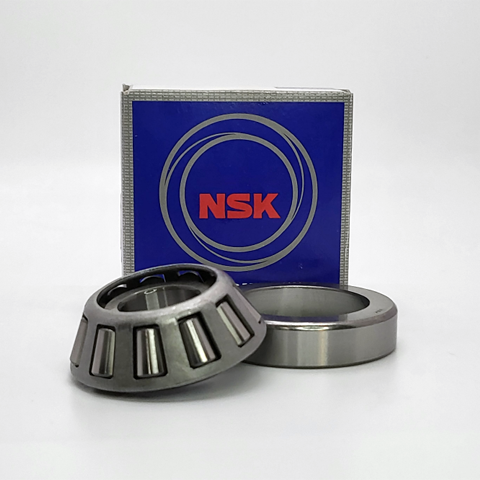
NSK NSK Tapered Roller Bearings, Single-Row Metric Design HR32010XJ ,D=50
NSK Tapered Roller Bearings, Single-Row Metric Design HR32010XJ ,D=50 Bearing Numbers Boundary Dimensions (mm) Basic Load Ratings (kN) Limiting Speeds (min-1) ISO355 Dimensions Series approx. Constant e Axial Load Factors Mass (kg) approx. d D T B C Cone r min. Cup r min. Cr C0r Grease Oil Y1 Y0 HR32010XJ 50 80 20 20 15.5 1 1 61 87 4300 6000 3CC 0.42 1.4 0.78 0.38 DESIGN, TYPES, AND FEATURES Tapered roller bearings are designed so the apices of the cones formed by the raceways of the inner and outer rings and the inner ring rollers all coincide at one point on the axis of the bearing. When a radial load is imposed, a component axial force occurs; therefore, it is necessary to use two bearings in opposition or some other multiple-bearing arrangement. For Metric Series medium-angle or steep-angle tapered roller bearings, the respective contact angle designation C or D is added after the bore number. For normal-angle tapered roller bearings, no contact angle designation is used. Medium-angle tapered roller bearings are primarily used for the pinion shafts of differential gears in automobiles. Some bearings with high load capacity (HR Series) contain a J suffix that indicates they conform to ISO specifications for outer ring back face raceway diameter, outer ring width, and contact angle. Therefore, the inner ring assembly and outer ring of bearings with a J suffix are internationally interchangeable. Some Metric Series tapered roller bearings specified by ISO 355 have different dimensions from past Series 3XX bearings. Some of these are listed in the bearing tables. These conform to ISO specifications for the small-end diameter of the inner ring and contact angle. The inner and outer ring assemblies are internationally interchangeable. The bearing designation structure, which has changed from the past, is listed below: Inch Series bearings also exist. Inner ring assemblies and outer rings are approximately formulated as follows (excluding four-row tapered roller bearings): Various arrangements of tapered roller bearings (excluding single-row bearings) are available. The cages of tapered roller bearings are usually made of pressed steel. Table 1 Design and Features of Tapered Roller Bearing Arrangements Design Arrangement Ex. Bearing Designation Features Back-to-back HR30210JDB+KLR10 Two standard bearings are combined. The bearing clearances are adjusted by inner ring spacers or outer ring spacers. The inner rings, outer rings, and spacers are marked with serial numbers and mating marks. Components with the same serial number can be assembled by referring to the matching indications. Face-to-face HR30210JDF+KR KBE Type 100KBE31+L The KBE type is a back-to-back arrangement of bearings with an integrated outer ring spacer. The KH type is a face-to-face arrangement in which the inner rings are integrated. Since the bearing clearance is adjusted using spacers, components must have the same serial number for assembly with reference to the matching indications. KH Type 110KH31+K
$42.22
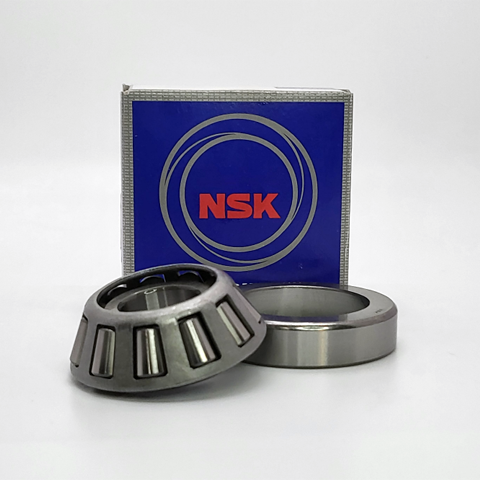
NSK NSK Tapered Roller Bearings, Single-Row Metric Design HR32009XJ ,D=45
NSK Tapered Roller Bearings, Single-Row Metric Design HR32009XJ ,D=45 Bearing Numbers Boundary Dimensions (mm) Basic Load Ratings (kN) Limiting Speeds (min-1) ISO355 Dimensions Series approx. Constant e Axial Load Factors Mass (kg) approx. d D T B C Cone r min. Cup r min. Cr C0r Grease Oil Y1 Y0 HR32009XJ 45 75 20 20 15.5 1 1 60 83 4500 6300 3CC 0.39 1.5 0.84 0.354 DESIGN, TYPES, AND FEATURES Tapered roller bearings are designed so the apices of the cones formed by the raceways of the inner and outer rings and the inner ring rollers all coincide at one point on the axis of the bearing. When a radial load is imposed, a component axial force occurs; therefore, it is necessary to use two bearings in opposition or some other multiple-bearing arrangement. For Metric Series medium-angle or steep-angle tapered roller bearings, the respective contact angle designation C or D is added after the bore number. For normal-angle tapered roller bearings, no contact angle designation is used. Medium-angle tapered roller bearings are primarily used for the pinion shafts of differential gears in automobiles. Some bearings with high load capacity (HR Series) contain a J suffix that indicates they conform to ISO specifications for outer ring back face raceway diameter, outer ring width, and contact angle. Therefore, the inner ring assembly and outer ring of bearings with a J suffix are internationally interchangeable. Some Metric Series tapered roller bearings specified by ISO 355 have different dimensions from past Series 3XX bearings. Some of these are listed in the bearing tables. These conform to ISO specifications for the small-end diameter of the inner ring and contact angle. The inner and outer ring assemblies are internationally interchangeable. The bearing designation structure, which has changed from the past, is listed below: Inch Series bearings also exist. Inner ring assemblies and outer rings are approximately formulated as follows (excluding four-row tapered roller bearings): Various arrangements of tapered roller bearings (excluding single-row bearings) are available. The cages of tapered roller bearings are usually made of pressed steel. Table 1 Design and Features of Tapered Roller Bearing Arrangements Design Arrangement Ex. Bearing Designation Features Back-to-back HR30210JDB+KLR10 Two standard bearings are combined. The bearing clearances are adjusted by inner ring spacers or outer ring spacers. The inner rings, outer rings, and spacers are marked with serial numbers and mating marks. Components with the same serial number can be assembled by referring to the matching indications. Face-to-face HR30210JDF+KR KBE Type 100KBE31+L The KBE type is a back-to-back arrangement of bearings with an integrated outer ring spacer. The KH type is a face-to-face arrangement in which the inner rings are integrated. Since the bearing clearance is adjusted using spacers, components must have the same serial number for assembly with reference to the matching indications. KH Type 110KH31+K
$36.38
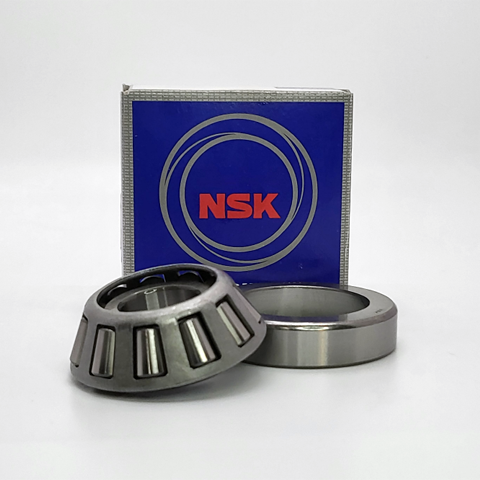
NSK NSK Tapered Roller Bearings, Single-Row Metric Design HR32008XJ ,D=40
NSK Tapered Roller Bearings, Single-Row Metric Design HR32008XJ ,D=40 Bearing Numbers Boundary Dimensions (mm) Basic Load Ratings (kN) Limiting Speeds (min-1) ISO355 Dimensions Series approx. Constant e Axial Load Factors Mass (kg) approx. d D T B C Cone r min. Cup r min. Cr C0r Grease Oil Y1 Y0 HR32008XJ 40 68 19 19 14.5 1 1 53 71 5300 7100 3CD 0.38 1.6 0.87 0.28 DESIGN, TYPES, AND FEATURES Tapered roller bearings are designed so the apices of the cones formed by the raceways of the inner and outer rings and the inner ring rollers all coincide at one point on the axis of the bearing. When a radial load is imposed, a component axial force occurs; therefore, it is necessary to use two bearings in opposition or some other multiple-bearing arrangement. For Metric Series medium-angle or steep-angle tapered roller bearings, the respective contact angle designation C or D is added after the bore number. For normal-angle tapered roller bearings, no contact angle designation is used. Medium-angle tapered roller bearings are primarily used for the pinion shafts of differential gears in automobiles. Some bearings with high load capacity (HR Series) contain a J suffix that indicates they conform to ISO specifications for outer ring back face raceway diameter, outer ring width, and contact angle. Therefore, the inner ring assembly and outer ring of bearings with a J suffix are internationally interchangeable. Some Metric Series tapered roller bearings specified by ISO 355 have different dimensions from past Series 3XX bearings. Some of these are listed in the bearing tables. These conform to ISO specifications for the small-end diameter of the inner ring and contact angle. The inner and outer ring assemblies are internationally interchangeable. The bearing designation structure, which has changed from the past, is listed below: Inch Series bearings also exist. Inner ring assemblies and outer rings are approximately formulated as follows (excluding four-row tapered roller bearings): Various arrangements of tapered roller bearings (excluding single-row bearings) are available. The cages of tapered roller bearings are usually made of pressed steel. Table 1 Design and Features of Tapered Roller Bearing Arrangements Design Arrangement Ex. Bearing Designation Features Back-to-back HR30210JDB+KLR10 Two standard bearings are combined. The bearing clearances are adjusted by inner ring spacers or outer ring spacers. The inner rings, outer rings, and spacers are marked with serial numbers and mating marks. Components with the same serial number can be assembled by referring to the matching indications. Face-to-face HR30210JDF+KR KBE Type 100KBE31+L The KBE type is a back-to-back arrangement of bearings with an integrated outer ring spacer. The KH type is a face-to-face arrangement in which the inner rings are integrated. Since the bearing clearance is adjusted using spacers, components must have the same serial number for assembly with reference to the matching indications. KH Type 110KH31+K
$32.30
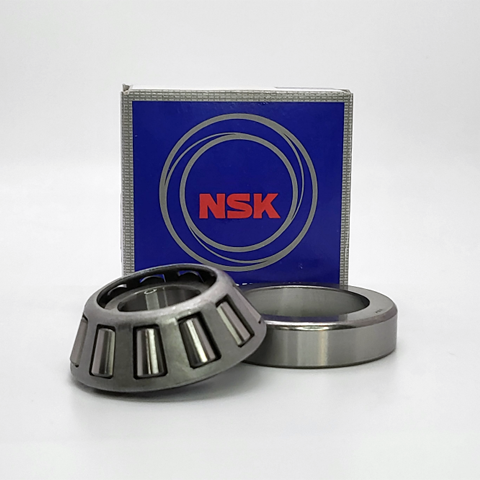
NSK NSK Tapered Roller Bearings, Single-Row Metric Design HR32007XJ ,D=35
NSK Tapered Roller Bearings, Single-Row Metric Design HR32007XJ ,D=35 Bearing Numbers Boundary Dimensions (mm) Basic Load Ratings (kN) Limiting Speeds (min-1) ISO355 Dimensions Series approx. Constant e Axial Load Factors Mass (kg) approx. d D T B C Cone r min. Cup r min. Cr C0r Grease Oil Y1 Y0 HR32007XJ 35 62 18 18 14 1 1 43.5 55.5 5600 8000 4CC 0.45 1.3 0.73 0.229 DESIGN, TYPES, AND FEATURES Tapered roller bearings are designed so the apices of the cones formed by the raceways of the inner and outer rings and the inner ring rollers all coincide at one point on the axis of the bearing. When a radial load is imposed, a component axial force occurs; therefore, it is necessary to use two bearings in opposition or some other multiple-bearing arrangement. For Metric Series medium-angle or steep-angle tapered roller bearings, the respective contact angle designation C or D is added after the bore number. For normal-angle tapered roller bearings, no contact angle designation is used. Medium-angle tapered roller bearings are primarily used for the pinion shafts of differential gears in automobiles. Some bearings with high load capacity (HR Series) contain a J suffix that indicates they conform to ISO specifications for outer ring back face raceway diameter, outer ring width, and contact angle. Therefore, the inner ring assembly and outer ring of bearings with a J suffix are internationally interchangeable. Some Metric Series tapered roller bearings specified by ISO 355 have different dimensions from past Series 3XX bearings. Some of these are listed in the bearing tables. These conform to ISO specifications for the small-end diameter of the inner ring and contact angle. The inner and outer ring assemblies are internationally interchangeable. The bearing designation structure, which has changed from the past, is listed below: Inch Series bearings also exist. Inner ring assemblies and outer rings are approximately formulated as follows (excluding four-row tapered roller bearings): Various arrangements of tapered roller bearings (excluding single-row bearings) are available. The cages of tapered roller bearings are usually made of pressed steel. Table 1 Design and Features of Tapered Roller Bearing Arrangements Design Arrangement Ex. Bearing Designation Features Back-to-back HR30210JDB+KLR10 Two standard bearings are combined. The bearing clearances are adjusted by inner ring spacers or outer ring spacers. The inner rings, outer rings, and spacers are marked with serial numbers and mating marks. Components with the same serial number can be assembled by referring to the matching indications. Face-to-face HR30210JDF+KR KBE Type 100KBE31+L The KBE type is a back-to-back arrangement of bearings with an integrated outer ring spacer. The KH type is a face-to-face arrangement in which the inner rings are integrated. Since the bearing clearance is adjusted using spacers, components must have the same serial number for assembly with reference to the matching indications. KH Type 110KH31+K
$30.86
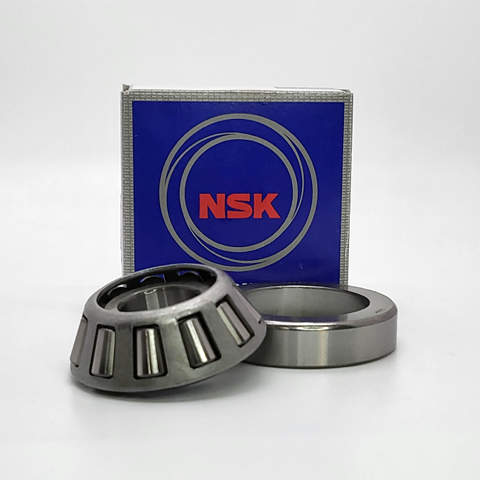
NSK NSK Tapered Roller Bearings, Single-Row Metric Design HR32006XJ ,D=30
NSK Tapered Roller Bearings, Single-Row Metric Design HR32006XJ ,D=30 Bearing Numbers Boundary Dimensions (mm) Basic Load Ratings (kN) Limiting Speeds (min-1) ISO355 Dimensions Series approx. Constant e Axial Load Factors Mass (kg) approx. d D T B C Cone r min. Cup r min. Cr C0r Grease Oil Y1 Y0 HR32006XJ 30 55 17 17 13 1 1 36 44.5 6700 9000 4CC 0.43 1.4 0.77 0.172 DESIGN, TYPES, AND FEATURES Tapered roller bearings are designed so the apices of the cones formed by the raceways of the inner and outer rings and the inner ring rollers all coincide at one point on the axis of the bearing. When a radial load is imposed, a component axial force occurs; therefore, it is necessary to use two bearings in opposition or some other multiple-bearing arrangement. For Metric Series medium-angle or steep-angle tapered roller bearings, the respective contact angle designation C or D is added after the bore number. For normal-angle tapered roller bearings, no contact angle designation is used. Medium-angle tapered roller bearings are primarily used for the pinion shafts of differential gears in automobiles. Some bearings with high load capacity (HR Series) contain a J suffix that indicates they conform to ISO specifications for outer ring back face raceway diameter, outer ring width, and contact angle. Therefore, the inner ring assembly and outer ring of bearings with a J suffix are internationally interchangeable. Some Metric Series tapered roller bearings specified by ISO 355 have different dimensions from past Series 3XX bearings. Some of these are listed in the bearing tables. These conform to ISO specifications for the small-end diameter of the inner ring and contact angle. The inner and outer ring assemblies are internationally interchangeable. The bearing designation structure, which has changed from the past, is listed below: Inch Series bearings also exist. Inner ring assemblies and outer rings are approximately formulated as follows (excluding four-row tapered roller bearings): Various arrangements of tapered roller bearings (excluding single-row bearings) are available. The cages of tapered roller bearings are usually made of pressed steel. Table 1 Design and Features of Tapered Roller Bearing Arrangements Design Arrangement Ex. Bearing Designation Features Back-to-back HR30210JDB+KLR10 Two standard bearings are combined. The bearing clearances are adjusted by inner ring spacers or outer ring spacers. The inner rings, outer rings, and spacers are marked with serial numbers and mating marks. Components with the same serial number can be assembled by referring to the matching indications. Face-to-face HR30210JDF+KR KBE Type 100KBE31+L The KBE type is a back-to-back arrangement of bearings with an integrated outer ring spacer. The KH type is a face-to-face arrangement in which the inner rings are integrated. Since the bearing clearance is adjusted using spacers, components must have the same serial number for assembly with reference to the matching indications. KH Type 110KH31+K
$26.16
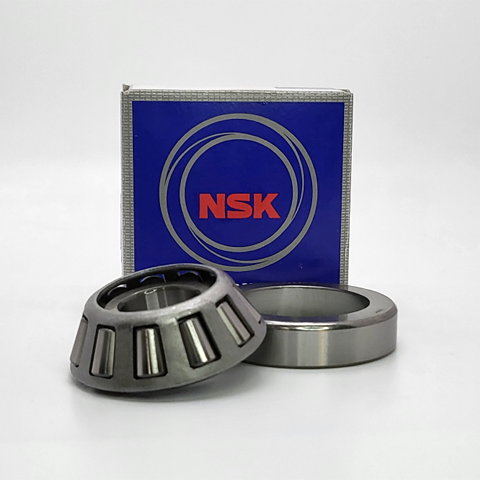
NSK NSK Tapered Roller Bearings, Single-Row Metric Design HR32005XJ ,D=25
NSK Tapered Roller Bearings, Single-Row Metric Design HR32005XJ ,D=25 Bearing Numbers Boundary Dimensions (mm) Basic Load Ratings (kN) Limiting Speeds (min-1) ISO355 Dimensions Series approx. Constant e Axial Load Factors Mass (kg) approx. d D T B C Cone r min. Cup r min. Cr C0r Grease Oil Y1 Y0 HR32005XJ 25 47 15 15 11.5 0.6 0.6 27.4 33 8000 11000 4CC 0.43 1.4 0.77 0.116 DESIGN, TYPES, AND FEATURES Tapered roller bearings are designed so the apices of the cones formed by the raceways of the inner and outer rings and the inner ring rollers all coincide at one point on the axis of the bearing. When a radial load is imposed, a component axial force occurs; therefore, it is necessary to use two bearings in opposition or some other multiple-bearing arrangement. For Metric Series medium-angle or steep-angle tapered roller bearings, the respective contact angle designation C or D is added after the bore number. For normal-angle tapered roller bearings, no contact angle designation is used. Medium-angle tapered roller bearings are primarily used for the pinion shafts of differential gears in automobiles. Some bearings with high load capacity (HR Series) contain a J suffix that indicates they conform to ISO specifications for outer ring back face raceway diameter, outer ring width, and contact angle. Therefore, the inner ring assembly and outer ring of bearings with a J suffix are internationally interchangeable. Some Metric Series tapered roller bearings specified by ISO 355 have different dimensions from past Series 3XX bearings. Some of these are listed in the bearing tables. These conform to ISO specifications for the small-end diameter of the inner ring and contact angle. The inner and outer ring assemblies are internationally interchangeable. The bearing designation structure, which has changed from the past, is listed below: Inch Series bearings also exist. Inner ring assemblies and outer rings are approximately formulated as follows (excluding four-row tapered roller bearings): Various arrangements of tapered roller bearings (excluding single-row bearings) are available. The cages of tapered roller bearings are usually made of pressed steel. Table 1 Design and Features of Tapered Roller Bearing Arrangements Design Arrangement Ex. Bearing Designation Features Back-to-back HR30210JDB+KLR10 Two standard bearings are combined. The bearing clearances are adjusted by inner ring spacers or outer ring spacers. The inner rings, outer rings, and spacers are marked with serial numbers and mating marks. Components with the same serial number can be assembled by referring to the matching indications. Face-to-face HR30210JDF+KR KBE Type 100KBE31+L The KBE type is a back-to-back arrangement of bearings with an integrated outer ring spacer. The KH type is a face-to-face arrangement in which the inner rings are integrated. Since the bearing clearance is adjusted using spacers, components must have the same serial number for assembly with reference to the matching indications. KH Type 110KH31+K
$23.32
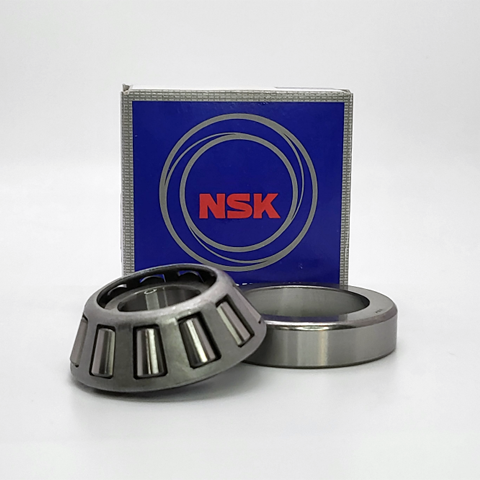
NSK NSK Tapered Roller Bearings, Single-Row Metric Design HR32004XJ ,D=20
NSK Tapered Roller Bearings, Single-Row Metric Design HR32004XJ ,D=20 Bearing Numbers Boundary Dimensions (mm) Basic Load Ratings (kN) Limiting Speeds (min-1) ISO355 Dimensions Series approx. Constant e Axial Load Factors Mass (kg) approx. d D T B C Cone r min. Cup r min. Cr C0r Grease Oil Y1 Y0 HR32004XJ 20 42 15 15 12 0.6 0.6 24.6 27.4 9000 12000 3CC 0.37 1.6 0.88 0.097 DESIGN, TYPES, AND FEATURES Tapered roller bearings are designed so the apices of the cones formed by the raceways of the inner and outer rings and the inner ring rollers all coincide at one point on the axis of the bearing. When a radial load is imposed, a component axial force occurs; therefore, it is necessary to use two bearings in opposition or some other multiple-bearing arrangement. For Metric Series medium-angle or steep-angle tapered roller bearings, the respective contact angle designation C or D is added after the bore number. For normal-angle tapered roller bearings, no contact angle designation is used. Medium-angle tapered roller bearings are primarily used for the pinion shafts of differential gears in automobiles. Some bearings with high load capacity (HR Series) contain a J suffix that indicates they conform to ISO specifications for outer ring back face raceway diameter, outer ring width, and contact angle. Therefore, the inner ring assembly and outer ring of bearings with a J suffix are internationally interchangeable. Some Metric Series tapered roller bearings specified by ISO 355 have different dimensions from past Series 3XX bearings. Some of these are listed in the bearing tables. These conform to ISO specifications for the small-end diameter of the inner ring and contact angle. The inner and outer ring assemblies are internationally interchangeable. The bearing designation structure, which has changed from the past, is listed below: Inch Series bearings also exist. Inner ring assemblies and outer rings are approximately formulated as follows (excluding four-row tapered roller bearings): Various arrangements of tapered roller bearings (excluding single-row bearings) are available. The cages of tapered roller bearings are usually made of pressed steel. Table 1 Design and Features of Tapered Roller Bearing Arrangements Design Arrangement Ex. Bearing Designation Features Back-to-back HR30210JDB+KLR10 Two standard bearings are combined. The bearing clearances are adjusted by inner ring spacers or outer ring spacers. The inner rings, outer rings, and spacers are marked with serial numbers and mating marks. Components with the same serial number can be assembled by referring to the matching indications. Face-to-face HR30210JDF+KR KBE Type 100KBE31+L The KBE type is a back-to-back arrangement of bearings with an integrated outer ring spacer. The KH type is a face-to-face arrangement in which the inner rings are integrated. Since the bearing clearance is adjusted using spacers, components must have the same serial number for assembly with reference to the matching indications. KH Type 110KH31+K
$16.44
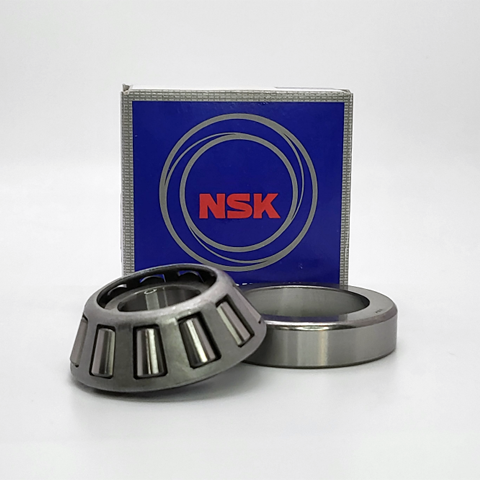
NSK NSK Tapered Roller Bearings, Single-Row Metric Design HR30324J ,D=120
NSK Tapered Roller Bearings, Single-Row Metric Design HR30324J ,D=120 Bearing Numbers Boundary Dimensions (mm) Basic Load Ratings (kN) Limiting Speeds (min-1) ISO355 Dimensions Series approx. Constant e Axial Load Factors Mass (kg) approx. d D T B C Cone r min. Cup r min. Cr C0r Grease Oil Y1 Y0 HR30324J 120 260 59.5 55 46 4 3 535 655 1400 1900 2GB 0.35 1.7 0.96 13.9 DESIGN, TYPES, AND FEATURES Tapered roller bearings are designed so the apices of the cones formed by the raceways of the inner and outer rings and the inner ring rollers all coincide at one point on the axis of the bearing. When a radial load is imposed, a component axial force occurs; therefore, it is necessary to use two bearings in opposition or some other multiple-bearing arrangement. For Metric Series medium-angle or steep-angle tapered roller bearings, the respective contact angle designation C or D is added after the bore number. For normal-angle tapered roller bearings, no contact angle designation is used. Medium-angle tapered roller bearings are primarily used for the pinion shafts of differential gears in automobiles. Some bearings with high load capacity (HR Series) contain a J suffix that indicates they conform to ISO specifications for outer ring back face raceway diameter, outer ring width, and contact angle. Therefore, the inner ring assembly and outer ring of bearings with a J suffix are internationally interchangeable. Some Metric Series tapered roller bearings specified by ISO 355 have different dimensions from past Series 3XX bearings. Some of these are listed in the bearing tables. These conform to ISO specifications for the small-end diameter of the inner ring and contact angle. The inner and outer ring assemblies are internationally interchangeable. The bearing designation structure, which has changed from the past, is listed below: Inch Series bearings also exist. Inner ring assemblies and outer rings are approximately formulated as follows (excluding four-row tapered roller bearings): Various arrangements of tapered roller bearings (excluding single-row bearings) are available. The cages of tapered roller bearings are usually made of pressed steel. Table 1 Design and Features of Tapered Roller Bearing Arrangements Design Arrangement Ex. Bearing Designation Features Back-to-back HR30210JDB+KLR10 Two standard bearings are combined. The bearing clearances are adjusted by inner ring spacers or outer ring spacers. The inner rings, outer rings, and spacers are marked with serial numbers and mating marks. Components with the same serial number can be assembled by referring to the matching indications. Face-to-face HR30210JDF+KR KBE Type 100KBE31+L The KBE type is a back-to-back arrangement of bearings with an integrated outer ring spacer. The KH type is a face-to-face arrangement in which the inner rings are integrated. Since the bearing clearance is adjusted using spacers, components must have the same serial number for assembly with reference to the matching indications. KH Type 110KH31+K
$1,208.26
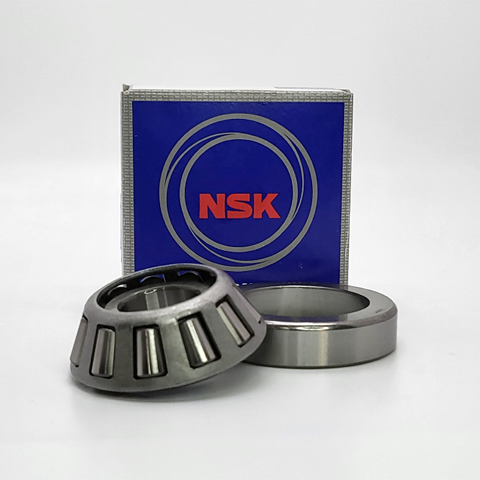
NSK NSK Tapered Roller Bearings, Single-Row Metric Design HR30322J ,D=110
NSK Tapered Roller Bearings, Single-Row Metric Design HR30322J ,D=110 Bearing Numbers Boundary Dimensions (mm) Basic Load Ratings (kN) Limiting Speeds (min-1) ISO355 Dimensions Series approx. Constant e Axial Load Factors Mass (kg) approx. d D T B C Cone r min. Cup r min. Cr C0r Grease Oil Y1 Y0 HR30322J 110 240 54.5 50 42 4 3 485 595 1500 2000 2GB 0.35 1.7 0.96 11 DESIGN, TYPES, AND FEATURES Tapered roller bearings are designed so the apices of the cones formed by the raceways of the inner and outer rings and the inner ring rollers all coincide at one point on the axis of the bearing. When a radial load is imposed, a component axial force occurs; therefore, it is necessary to use two bearings in opposition or some other multiple-bearing arrangement. For Metric Series medium-angle or steep-angle tapered roller bearings, the respective contact angle designation C or D is added after the bore number. For normal-angle tapered roller bearings, no contact angle designation is used. Medium-angle tapered roller bearings are primarily used for the pinion shafts of differential gears in automobiles. Some bearings with high load capacity (HR Series) contain a J suffix that indicates they conform to ISO specifications for outer ring back face raceway diameter, outer ring width, and contact angle. Therefore, the inner ring assembly and outer ring of bearings with a J suffix are internationally interchangeable. Some Metric Series tapered roller bearings specified by ISO 355 have different dimensions from past Series 3XX bearings. Some of these are listed in the bearing tables. These conform to ISO specifications for the small-end diameter of the inner ring and contact angle. The inner and outer ring assemblies are internationally interchangeable. The bearing designation structure, which has changed from the past, is listed below: Inch Series bearings also exist. Inner ring assemblies and outer rings are approximately formulated as follows (excluding four-row tapered roller bearings): Various arrangements of tapered roller bearings (excluding single-row bearings) are available. The cages of tapered roller bearings are usually made of pressed steel. Table 1 Design and Features of Tapered Roller Bearing Arrangements Design Arrangement Ex. Bearing Designation Features Back-to-back HR30210JDB+KLR10 Two standard bearings are combined. The bearing clearances are adjusted by inner ring spacers or outer ring spacers. The inner rings, outer rings, and spacers are marked with serial numbers and mating marks. Components with the same serial number can be assembled by referring to the matching indications. Face-to-face HR30210JDF+KR KBE Type 100KBE31+L The KBE type is a back-to-back arrangement of bearings with an integrated outer ring spacer. The KH type is a face-to-face arrangement in which the inner rings are integrated. Since the bearing clearance is adjusted using spacers, components must have the same serial number for assembly with reference to the matching indications. KH Type 110KH31+K
$1,059.88
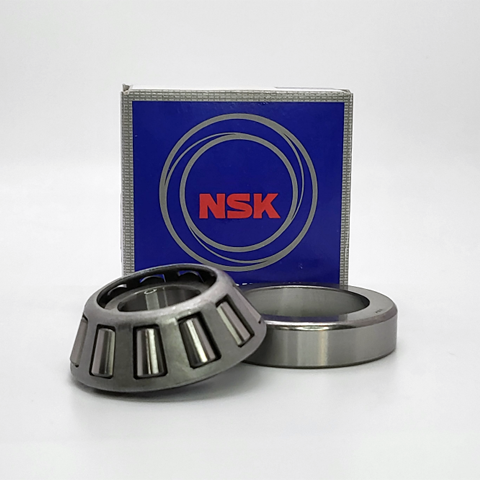
NSK NSK Tapered Roller Bearings, Single-Row Metric Design HR30321J ,D=105
NSK Tapered Roller Bearings, Single-Row Metric Design HR30321J ,D=105 Bearing Numbers Boundary Dimensions (mm) Basic Load Ratings (kN) Limiting Speeds (min-1) ISO355 Dimensions Series approx. Constant e Axial Load Factors Mass (kg) approx. d D T B C Cone r min. Cup r min. Cr C0r Grease Oil Y1 Y0 HR30321J 105 225 53.5 49 41 4 3 455 565 1600 2200 2GB 0.35 1.7 0.96 9.52 DESIGN, TYPES, AND FEATURES Tapered roller bearings are designed so the apices of the cones formed by the raceways of the inner and outer rings and the inner ring rollers all coincide at one point on the axis of the bearing. When a radial load is imposed, a component axial force occurs; therefore, it is necessary to use two bearings in opposition or some other multiple-bearing arrangement. For Metric Series medium-angle or steep-angle tapered roller bearings, the respective contact angle designation C or D is added after the bore number. For normal-angle tapered roller bearings, no contact angle designation is used. Medium-angle tapered roller bearings are primarily used for the pinion shafts of differential gears in automobiles. Some bearings with high load capacity (HR Series) contain a J suffix that indicates they conform to ISO specifications for outer ring back face raceway diameter, outer ring width, and contact angle. Therefore, the inner ring assembly and outer ring of bearings with a J suffix are internationally interchangeable. Some Metric Series tapered roller bearings specified by ISO 355 have different dimensions from past Series 3XX bearings. Some of these are listed in the bearing tables. These conform to ISO specifications for the small-end diameter of the inner ring and contact angle. The inner and outer ring assemblies are internationally interchangeable. The bearing designation structure, which has changed from the past, is listed below: Inch Series bearings also exist. Inner ring assemblies and outer rings are approximately formulated as follows (excluding four-row tapered roller bearings): Various arrangements of tapered roller bearings (excluding single-row bearings) are available. The cages of tapered roller bearings are usually made of pressed steel. Table 1 Design and Features of Tapered Roller Bearing Arrangements Design Arrangement Ex. Bearing Designation Features Back-to-back HR30210JDB+KLR10 Two standard bearings are combined. The bearing clearances are adjusted by inner ring spacers or outer ring spacers. The inner rings, outer rings, and spacers are marked with serial numbers and mating marks. Components with the same serial number can be assembled by referring to the matching indications. Face-to-face HR30210JDF+KR KBE Type 100KBE31+L The KBE type is a back-to-back arrangement of bearings with an integrated outer ring spacer. The KH type is a face-to-face arrangement in which the inner rings are integrated. Since the bearing clearance is adjusted using spacers, components must have the same serial number for assembly with reference to the matching indications. KH Type 110KH31+K
$938.44
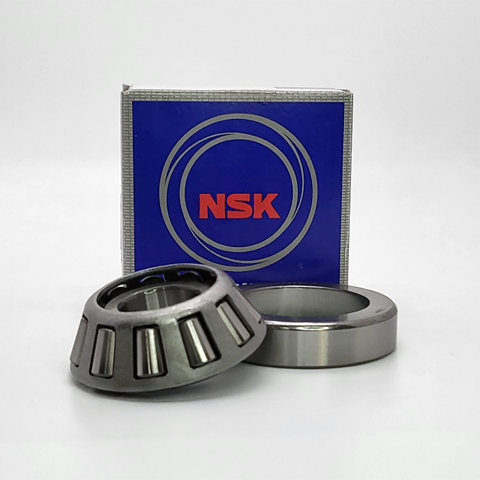
NSK NSK Tapered Roller Bearings, Single-Row Metric Design HR30320J ,D=100
NSK Tapered Roller Bearings, Single-Row Metric Design HR30320J ,D=100 Bearing Numbers Boundary Dimensions (mm) Basic Load Ratings (kN) Limiting Speeds (min-1) ISO355 Dimensions Series approx. Constant e Axial Load Factors Mass (kg) approx. d D T B C Cone r min. Cup r min. Cr C0r Grease Oil Y1 Y0 HR30320J 100 215 51.5 47 39 4 3 425 525 1700 2400 2GB 0.35 1.7 0.96 8.41 DESIGN, TYPES, AND FEATURES Tapered roller bearings are designed so the apices of the cones formed by the raceways of the inner and outer rings and the inner ring rollers all coincide at one point on the axis of the bearing. When a radial load is imposed, a component axial force occurs; therefore, it is necessary to use two bearings in opposition or some other multiple-bearing arrangement. For Metric Series medium-angle or steep-angle tapered roller bearings, the respective contact angle designation C or D is added after the bore number. For normal-angle tapered roller bearings, no contact angle designation is used. Medium-angle tapered roller bearings are primarily used for the pinion shafts of differential gears in automobiles. Some bearings with high load capacity (HR Series) contain a J suffix that indicates they conform to ISO specifications for outer ring back face raceway diameter, outer ring width, and contact angle. Therefore, the inner ring assembly and outer ring of bearings with a J suffix are internationally interchangeable. Some Metric Series tapered roller bearings specified by ISO 355 have different dimensions from past Series 3XX bearings. Some of these are listed in the bearing tables. These conform to ISO specifications for the small-end diameter of the inner ring and contact angle. The inner and outer ring assemblies are internationally interchangeable. The bearing designation structure, which has changed from the past, is listed below: Inch Series bearings also exist. Inner ring assemblies and outer rings are approximately formulated as follows (excluding four-row tapered roller bearings): Various arrangements of tapered roller bearings (excluding single-row bearings) are available. The cages of tapered roller bearings are usually made of pressed steel. Table 1 Design and Features of Tapered Roller Bearing Arrangements Design Arrangement Ex. Bearing Designation Features Back-to-back HR30210JDB+KLR10 Two standard bearings are combined. The bearing clearances are adjusted by inner ring spacers or outer ring spacers. The inner rings, outer rings, and spacers are marked with serial numbers and mating marks. Components with the same serial number can be assembled by referring to the matching indications. Face-to-face HR30210JDF+KR KBE Type 100KBE31+L The KBE type is a back-to-back arrangement of bearings with an integrated outer ring spacer. The KH type is a face-to-face arrangement in which the inner rings are integrated. Since the bearing clearance is adjusted using spacers, components must have the same serial number for assembly with reference to the matching indications. KH Type 110KH31+K
$662.88
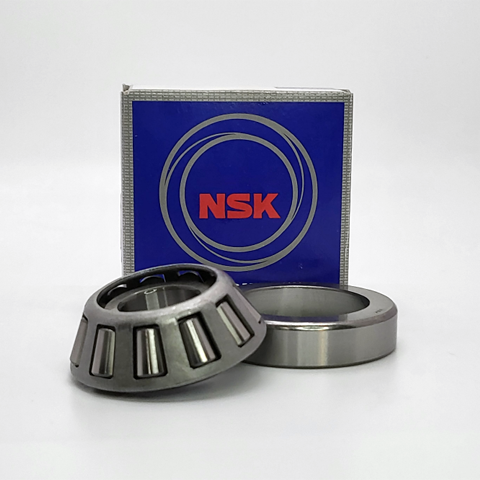
NSK NSK Tapered Roller Bearings, Single-Row Metric Design HR30319J ,D=95
NSK Tapered Roller Bearings, Single-Row Metric Design HR30319J ,D=95 Bearing Numbers Boundary Dimensions (mm) Basic Load Ratings (kN) Limiting Speeds (min-1) ISO355 Dimensions Series approx. Constant e Axial Load Factors Mass (kg) approx. d D T B C Cone r min. Cup r min. Cr C0r Grease Oil Y1 Y0 HR30319J 95 200 49.5 45 38 4 3 370 455 1900 2600 2GB 0.35 1.7 0.96 6.92 DESIGN, TYPES, AND FEATURES Tapered roller bearings are designed so the apices of the cones formed by the raceways of the inner and outer rings and the inner ring rollers all coincide at one point on the axis of the bearing. When a radial load is imposed, a component axial force occurs; therefore, it is necessary to use two bearings in opposition or some other multiple-bearing arrangement. For Metric Series medium-angle or steep-angle tapered roller bearings, the respective contact angle designation C or D is added after the bore number. For normal-angle tapered roller bearings, no contact angle designation is used. Medium-angle tapered roller bearings are primarily used for the pinion shafts of differential gears in automobiles. Some bearings with high load capacity (HR Series) contain a J suffix that indicates they conform to ISO specifications for outer ring back face raceway diameter, outer ring width, and contact angle. Therefore, the inner ring assembly and outer ring of bearings with a J suffix are internationally interchangeable. Some Metric Series tapered roller bearings specified by ISO 355 have different dimensions from past Series 3XX bearings. Some of these are listed in the bearing tables. These conform to ISO specifications for the small-end diameter of the inner ring and contact angle. The inner and outer ring assemblies are internationally interchangeable. The bearing designation structure, which has changed from the past, is listed below: Inch Series bearings also exist. Inner ring assemblies and outer rings are approximately formulated as follows (excluding four-row tapered roller bearings): Various arrangements of tapered roller bearings (excluding single-row bearings) are available. The cages of tapered roller bearings are usually made of pressed steel. Table 1 Design and Features of Tapered Roller Bearing Arrangements Design Arrangement Ex. Bearing Designation Features Back-to-back HR30210JDB+KLR10 Two standard bearings are combined. The bearing clearances are adjusted by inner ring spacers or outer ring spacers. The inner rings, outer rings, and spacers are marked with serial numbers and mating marks. Components with the same serial number can be assembled by referring to the matching indications. Face-to-face HR30210JDF+KR KBE Type 100KBE31+L The KBE type is a back-to-back arrangement of bearings with an integrated outer ring spacer. The KH type is a face-to-face arrangement in which the inner rings are integrated. Since the bearing clearance is adjusted using spacers, components must have the same serial number for assembly with reference to the matching indications. KH Type 110KH31+K
$528.40
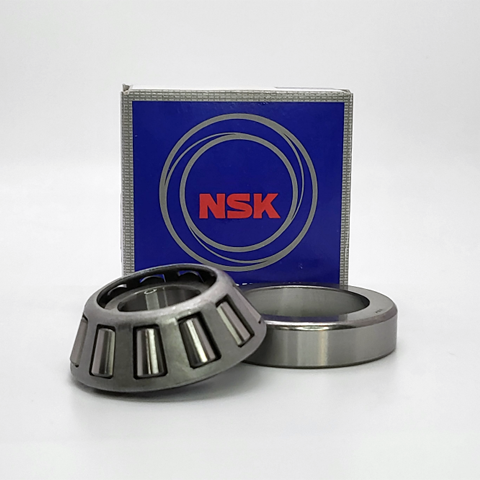
NSK NSK Tapered Roller Bearings, Single-Row Metric Design HR30318J ,D=90
NSK Tapered Roller Bearings, Single-Row Metric Design HR30318J ,D=90 Bearing Numbers Boundary Dimensions (mm) Basic Load Ratings (kN) Limiting Speeds (min-1) ISO355 Dimensions Series approx. Constant e Axial Load Factors Mass (kg) approx. d D T B C Cone r min. Cup r min. Cr C0r Grease Oil Y1 Y0 HR30318J 90 190 46.5 43 36 4 3 345 425 1900 2600 2GB 0.35 1.7 0.96 5.91 DESIGN, TYPES, AND FEATURES Tapered roller bearings are designed so the apices of the cones formed by the raceways of the inner and outer rings and the inner ring rollers all coincide at one point on the axis of the bearing. When a radial load is imposed, a component axial force occurs; therefore, it is necessary to use two bearings in opposition or some other multiple-bearing arrangement. For Metric Series medium-angle or steep-angle tapered roller bearings, the respective contact angle designation C or D is added after the bore number. For normal-angle tapered roller bearings, no contact angle designation is used. Medium-angle tapered roller bearings are primarily used for the pinion shafts of differential gears in automobiles. Some bearings with high load capacity (HR Series) contain a J suffix that indicates they conform to ISO specifications for outer ring back face raceway diameter, outer ring width, and contact angle. Therefore, the inner ring assembly and outer ring of bearings with a J suffix are internationally interchangeable. Some Metric Series tapered roller bearings specified by ISO 355 have different dimensions from past Series 3XX bearings. Some of these are listed in the bearing tables. These conform to ISO specifications for the small-end diameter of the inner ring and contact angle. The inner and outer ring assemblies are internationally interchangeable. The bearing designation structure, which has changed from the past, is listed below: Inch Series bearings also exist. Inner ring assemblies and outer rings are approximately formulated as follows (excluding four-row tapered roller bearings): Various arrangements of tapered roller bearings (excluding single-row bearings) are available. The cages of tapered roller bearings are usually made of pressed steel. Table 1 Design and Features of Tapered Roller Bearing Arrangements Design Arrangement Ex. Bearing Designation Features Back-to-back HR30210JDB+KLR10 Two standard bearings are combined. The bearing clearances are adjusted by inner ring spacers or outer ring spacers. The inner rings, outer rings, and spacers are marked with serial numbers and mating marks. Components with the same serial number can be assembled by referring to the matching indications. Face-to-face HR30210JDF+KR KBE Type 100KBE31+L The KBE type is a back-to-back arrangement of bearings with an integrated outer ring spacer. The KH type is a face-to-face arrangement in which the inner rings are integrated. Since the bearing clearance is adjusted using spacers, components must have the same serial number for assembly with reference to the matching indications. KH Type 110KH31+K
$403.68
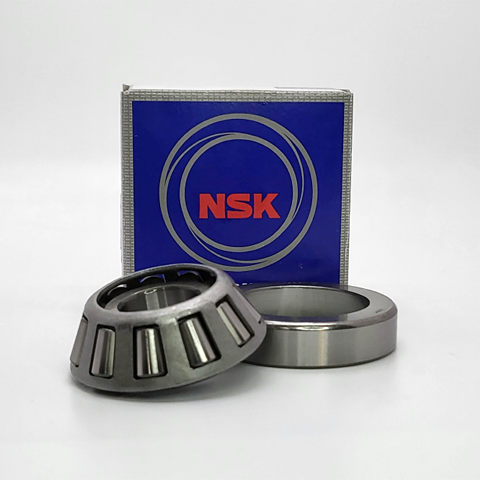
NSK NSK Tapered Roller Bearings, Single-Row Metric Design HR30317J ,D=85
NSK Tapered Roller Bearings, Single-Row Metric Design HR30317J ,D=85 Bearing Numbers Boundary Dimensions (mm) Basic Load Ratings (kN) Limiting Speeds (min-1) ISO355 Dimensions Series approx. Constant e Axial Load Factors Mass (kg) approx. d D T B C Cone r min. Cup r min. Cr C0r Grease Oil Y1 Y0 HR30317J 85 180 44.5 41 34 4 3 310 375 2000 2800 2GB 0.35 1.7 0.96 5.08 DESIGN, TYPES, AND FEATURES Tapered roller bearings are designed so the apices of the cones formed by the raceways of the inner and outer rings and the inner ring rollers all coincide at one point on the axis of the bearing. When a radial load is imposed, a component axial force occurs; therefore, it is necessary to use two bearings in opposition or some other multiple-bearing arrangement. For Metric Series medium-angle or steep-angle tapered roller bearings, the respective contact angle designation C or D is added after the bore number. For normal-angle tapered roller bearings, no contact angle designation is used. Medium-angle tapered roller bearings are primarily used for the pinion shafts of differential gears in automobiles. Some bearings with high load capacity (HR Series) contain a J suffix that indicates they conform to ISO specifications for outer ring back face raceway diameter, outer ring width, and contact angle. Therefore, the inner ring assembly and outer ring of bearings with a J suffix are internationally interchangeable. Some Metric Series tapered roller bearings specified by ISO 355 have different dimensions from past Series 3XX bearings. Some of these are listed in the bearing tables. These conform to ISO specifications for the small-end diameter of the inner ring and contact angle. The inner and outer ring assemblies are internationally interchangeable. The bearing designation structure, which has changed from the past, is listed below: Inch Series bearings also exist. Inner ring assemblies and outer rings are approximately formulated as follows (excluding four-row tapered roller bearings): Various arrangements of tapered roller bearings (excluding single-row bearings) are available. The cages of tapered roller bearings are usually made of pressed steel. Table 1 Design and Features of Tapered Roller Bearing Arrangements Design Arrangement Ex. Bearing Designation Features Back-to-back HR30210JDB+KLR10 Two standard bearings are combined. The bearing clearances are adjusted by inner ring spacers or outer ring spacers. The inner rings, outer rings, and spacers are marked with serial numbers and mating marks. Components with the same serial number can be assembled by referring to the matching indications. Face-to-face HR30210JDF+KR KBE Type 100KBE31+L The KBE type is a back-to-back arrangement of bearings with an integrated outer ring spacer. The KH type is a face-to-face arrangement in which the inner rings are integrated. Since the bearing clearance is adjusted using spacers, components must have the same serial number for assembly with reference to the matching indications. KH Type 110KH31+K
$319.10

NSK NSK Tapered Roller Bearings, Single-Row Metric Design HR30316J ,D=80
NSK Tapered Roller Bearings, Single-Row Metric Design HR30316J ,D=80 Bearing Numbers Boundary Dimensions (mm) Basic Load Ratings (kN) Limiting Speeds (min-1) ISO355 Dimensions Series approx. Constant e Axial Load Factors Mass (kg) approx. d D T B C Cone r min. Cup r min. Cr C0r Grease Oil Y1 Y0 HR30316J 80 170 42.5 39 33 3 2.5 276 330 2200 3000 2GB 0.35 1.7 0.96 4.27 DESIGN, TYPES, AND FEATURES Tapered roller bearings are designed so the apices of the cones formed by the raceways of the inner and outer rings and the inner ring rollers all coincide at one point on the axis of the bearing. When a radial load is imposed, a component axial force occurs; therefore, it is necessary to use two bearings in opposition or some other multiple-bearing arrangement. For Metric Series medium-angle or steep-angle tapered roller bearings, the respective contact angle designation C or D is added after the bore number. For normal-angle tapered roller bearings, no contact angle designation is used. Medium-angle tapered roller bearings are primarily used for the pinion shafts of differential gears in automobiles. Some bearings with high load capacity (HR Series) contain a J suffix that indicates they conform to ISO specifications for outer ring back face raceway diameter, outer ring width, and contact angle. Therefore, the inner ring assembly and outer ring of bearings with a J suffix are internationally interchangeable. Some Metric Series tapered roller bearings specified by ISO 355 have different dimensions from past Series 3XX bearings. Some of these are listed in the bearing tables. These conform to ISO specifications for the small-end diameter of the inner ring and contact angle. The inner and outer ring assemblies are internationally interchangeable. The bearing designation structure, which has changed from the past, is listed below: Inch Series bearings also exist. Inner ring assemblies and outer rings are approximately formulated as follows (excluding four-row tapered roller bearings): Various arrangements of tapered roller bearings (excluding single-row bearings) are available. The cages of tapered roller bearings are usually made of pressed steel. Table 1 Design and Features of Tapered Roller Bearing Arrangements Design Arrangement Ex. Bearing Designation Features Back-to-back HR30210JDB+KLR10 Two standard bearings are combined. The bearing clearances are adjusted by inner ring spacers or outer ring spacers. The inner rings, outer rings, and spacers are marked with serial numbers and mating marks. Components with the same serial number can be assembled by referring to the matching indications. Face-to-face HR30210JDF+KR KBE Type 100KBE31+L The KBE type is a back-to-back arrangement of bearings with an integrated outer ring spacer. The KH type is a face-to-face arrangement in which the inner rings are integrated. Since the bearing clearance is adjusted using spacers, components must have the same serial number for assembly with reference to the matching indications. KH Type 110KH31+K
$270.10
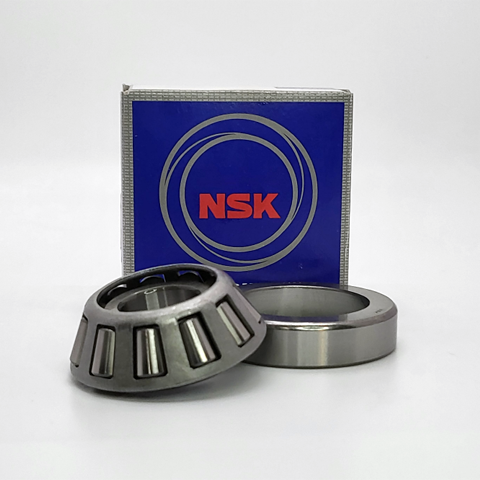
NSK NSK Tapered Roller Bearings, Single-Row Metric Design HR30315J ,D=75
NSK Tapered Roller Bearings, Single-Row Metric Design HR30315J ,D=75 Bearing Numbers Boundary Dimensions (mm) Basic Load Ratings (kN) Limiting Speeds (min-1) ISO355 Dimensions Series approx. Constant e Axial Load Factors Mass (kg) approx. d D T B C Cone r min. Cup r min. Cr C0r Grease Oil Y1 Y0 HR30315J 75 160 40 37 31 3 2.5 253 300 2400 3200 2GB 0.35 1.7 0.96 3.63 DESIGN, TYPES, AND FEATURES Tapered roller bearings are designed so the apices of the cones formed by the raceways of the inner and outer rings and the inner ring rollers all coincide at one point on the axis of the bearing. When a radial load is imposed, a component axial force occurs; therefore, it is necessary to use two bearings in opposition or some other multiple-bearing arrangement. For Metric Series medium-angle or steep-angle tapered roller bearings, the respective contact angle designation C or D is added after the bore number. For normal-angle tapered roller bearings, no contact angle designation is used. Medium-angle tapered roller bearings are primarily used for the pinion shafts of differential gears in automobiles. Some bearings with high load capacity (HR Series) contain a J suffix that indicates they conform to ISO specifications for outer ring back face raceway diameter, outer ring width, and contact angle. Therefore, the inner ring assembly and outer ring of bearings with a J suffix are internationally interchangeable. Some Metric Series tapered roller bearings specified by ISO 355 have different dimensions from past Series 3XX bearings. Some of these are listed in the bearing tables. These conform to ISO specifications for the small-end diameter of the inner ring and contact angle. The inner and outer ring assemblies are internationally interchangeable. The bearing designation structure, which has changed from the past, is listed below: Inch Series bearings also exist. Inner ring assemblies and outer rings are approximately formulated as follows (excluding four-row tapered roller bearings): Various arrangements of tapered roller bearings (excluding single-row bearings) are available. The cages of tapered roller bearings are usually made of pressed steel. Table 1 Design and Features of Tapered Roller Bearing Arrangements Design Arrangement Ex. Bearing Designation Features Back-to-back HR30210JDB+KLR10 Two standard bearings are combined. The bearing clearances are adjusted by inner ring spacers or outer ring spacers. The inner rings, outer rings, and spacers are marked with serial numbers and mating marks. Components with the same serial number can be assembled by referring to the matching indications. Face-to-face HR30210JDF+KR KBE Type 100KBE31+L The KBE type is a back-to-back arrangement of bearings with an integrated outer ring spacer. The KH type is a face-to-face arrangement in which the inner rings are integrated. Since the bearing clearance is adjusted using spacers, components must have the same serial number for assembly with reference to the matching indications. KH Type 110KH31+K
$205.66
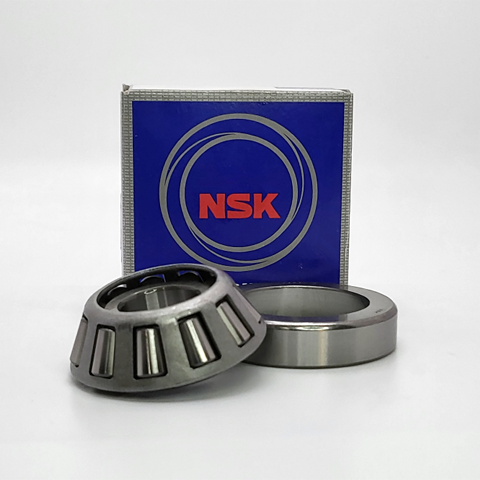
NSK NSK Tapered Roller Bearings, Single-Row Metric Design HR30314J ,D=70
NSK Tapered Roller Bearings, Single-Row Metric Design HR30314J ,D=70 Bearing Numbers Boundary Dimensions (mm) Basic Load Ratings (kN) Limiting Speeds (min-1) ISO355 Dimensions Series approx. Constant e Axial Load Factors Mass (kg) approx. d D T B C Cone r min. Cup r min. Cr C0r Grease Oil Y1 Y0 HR30314J 70 150 38 35 30 3 2.5 227 268 2400 3400 2GB 0.35 1.7 0.96 3.03 DESIGN, TYPES, AND FEATURES Tapered roller bearings are designed so the apices of the cones formed by the raceways of the inner and outer rings and the inner ring rollers all coincide at one point on the axis of the bearing. When a radial load is imposed, a component axial force occurs; therefore, it is necessary to use two bearings in opposition or some other multiple-bearing arrangement. For Metric Series medium-angle or steep-angle tapered roller bearings, the respective contact angle designation C or D is added after the bore number. For normal-angle tapered roller bearings, no contact angle designation is used. Medium-angle tapered roller bearings are primarily used for the pinion shafts of differential gears in automobiles. Some bearings with high load capacity (HR Series) contain a J suffix that indicates they conform to ISO specifications for outer ring back face raceway diameter, outer ring width, and contact angle. Therefore, the inner ring assembly and outer ring of bearings with a J suffix are internationally interchangeable. Some Metric Series tapered roller bearings specified by ISO 355 have different dimensions from past Series 3XX bearings. Some of these are listed in the bearing tables. These conform to ISO specifications for the small-end diameter of the inner ring and contact angle. The inner and outer ring assemblies are internationally interchangeable. The bearing designation structure, which has changed from the past, is listed below: Inch Series bearings also exist. Inner ring assemblies and outer rings are approximately formulated as follows (excluding four-row tapered roller bearings): Various arrangements of tapered roller bearings (excluding single-row bearings) are available. The cages of tapered roller bearings are usually made of pressed steel. Table 1 Design and Features of Tapered Roller Bearing Arrangements Design Arrangement Ex. Bearing Designation Features Back-to-back HR30210JDB+KLR10 Two standard bearings are combined. The bearing clearances are adjusted by inner ring spacers or outer ring spacers. The inner rings, outer rings, and spacers are marked with serial numbers and mating marks. Components with the same serial number can be assembled by referring to the matching indications. Face-to-face HR30210JDF+KR KBE Type 100KBE31+L The KBE type is a back-to-back arrangement of bearings with an integrated outer ring spacer. The KH type is a face-to-face arrangement in which the inner rings are integrated. Since the bearing clearance is adjusted using spacers, components must have the same serial number for assembly with reference to the matching indications. KH Type 110KH31+K
$221.16
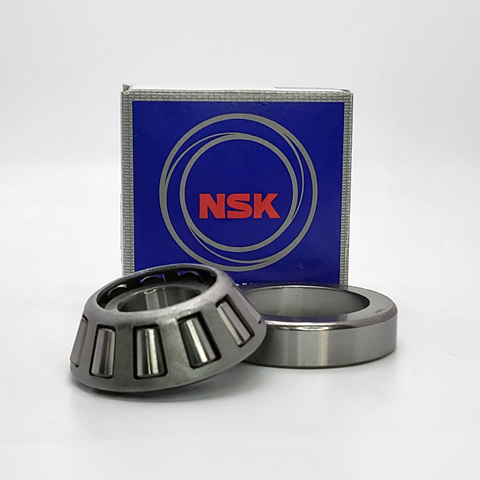
NSK NSK Tapered Roller Bearings, Single-Row Metric Design HR30313J ,D=65
NSK Tapered Roller Bearings, Single-Row Metric Design HR30313J ,D=65 Bearing Numbers Boundary Dimensions (mm) Basic Load Ratings (kN) Limiting Speeds (min-1) ISO355 Dimensions Series approx. Constant e Axial Load Factors Mass (kg) approx. d D T B C Cone r min. Cup r min. Cr C0r Grease Oil Y1 Y0 HR30313J 65 140 36 33 28 3 2.5 200 233 2600 3600 2GB 0.35 1.7 0.96 2.51 DESIGN, TYPES, AND FEATURES Tapered roller bearings are designed so the apices of the cones formed by the raceways of the inner and outer rings and the inner ring rollers all coincide at one point on the axis of the bearing. When a radial load is imposed, a component axial force occurs; therefore, it is necessary to use two bearings in opposition or some other multiple-bearing arrangement. For Metric Series medium-angle or steep-angle tapered roller bearings, the respective contact angle designation C or D is added after the bore number. For normal-angle tapered roller bearings, no contact angle designation is used. Medium-angle tapered roller bearings are primarily used for the pinion shafts of differential gears in automobiles. Some bearings with high load capacity (HR Series) contain a J suffix that indicates they conform to ISO specifications for outer ring back face raceway diameter, outer ring width, and contact angle. Therefore, the inner ring assembly and outer ring of bearings with a J suffix are internationally interchangeable. Some Metric Series tapered roller bearings specified by ISO 355 have different dimensions from past Series 3XX bearings. Some of these are listed in the bearing tables. These conform to ISO specifications for the small-end diameter of the inner ring and contact angle. The inner and outer ring assemblies are internationally interchangeable. The bearing designation structure, which has changed from the past, is listed below: Inch Series bearings also exist. Inner ring assemblies and outer rings are approximately formulated as follows (excluding four-row tapered roller bearings): Various arrangements of tapered roller bearings (excluding single-row bearings) are available. The cages of tapered roller bearings are usually made of pressed steel. Table 1 Design and Features of Tapered Roller Bearing Arrangements Design Arrangement Ex. Bearing Designation Features Back-to-back HR30210JDB+KLR10 Two standard bearings are combined. The bearing clearances are adjusted by inner ring spacers or outer ring spacers. The inner rings, outer rings, and spacers are marked with serial numbers and mating marks. Components with the same serial number can be assembled by referring to the matching indications. Face-to-face HR30210JDF+KR KBE Type 100KBE31+L The KBE type is a back-to-back arrangement of bearings with an integrated outer ring spacer. The KH type is a face-to-face arrangement in which the inner rings are integrated. Since the bearing clearance is adjusted using spacers, components must have the same serial number for assembly with reference to the matching indications. KH Type 110KH31+K
$180.64
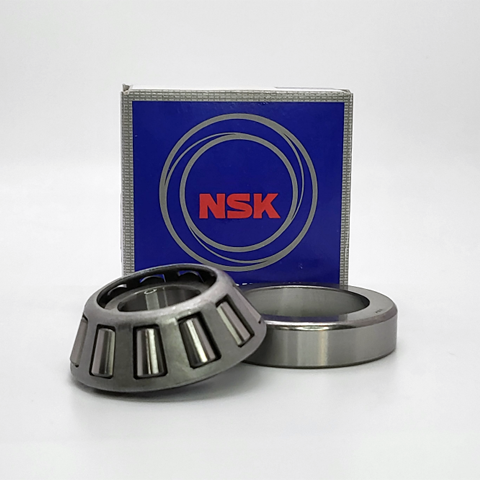
NSK NSK Tapered Roller Bearings, Single-Row Metric Design HR30312J ,D=60
NSK Tapered Roller Bearings, Single-Row Metric Design HR30312J ,D=60 Bearing Numbers Boundary Dimensions (mm) Basic Load Ratings (kN) Limiting Speeds (min-1) ISO355 Dimensions Series approx. Constant e Axial Load Factors Mass (kg) approx. d D T B C Cone r min. Cup r min. Cr C0r Grease Oil Y1 Y0 HR30312J 60 130 33.5 31 26 3 2.5 174 201 3000 4000 2FB 0.35 1.7 0.96 2.03 DESIGN, TYPES, AND FEATURES Tapered roller bearings are designed so the apices of the cones formed by the raceways of the inner and outer rings and the inner ring rollers all coincide at one point on the axis of the bearing. When a radial load is imposed, a component axial force occurs; therefore, it is necessary to use two bearings in opposition or some other multiple-bearing arrangement. For Metric Series medium-angle or steep-angle tapered roller bearings, the respective contact angle designation C or D is added after the bore number. For normal-angle tapered roller bearings, no contact angle designation is used. Medium-angle tapered roller bearings are primarily used for the pinion shafts of differential gears in automobiles. Some bearings with high load capacity (HR Series) contain a J suffix that indicates they conform to ISO specifications for outer ring back face raceway diameter, outer ring width, and contact angle. Therefore, the inner ring assembly and outer ring of bearings with a J suffix are internationally interchangeable. Some Metric Series tapered roller bearings specified by ISO 355 have different dimensions from past Series 3XX bearings. Some of these are listed in the bearing tables. These conform to ISO specifications for the small-end diameter of the inner ring and contact angle. The inner and outer ring assemblies are internationally interchangeable. The bearing designation structure, which has changed from the past, is listed below: Inch Series bearings also exist. Inner ring assemblies and outer rings are approximately formulated as follows (excluding four-row tapered roller bearings): Various arrangements of tapered roller bearings (excluding single-row bearings) are available. The cages of tapered roller bearings are usually made of pressed steel. Table 1 Design and Features of Tapered Roller Bearing Arrangements Design Arrangement Ex. Bearing Designation Features Back-to-back HR30210JDB+KLR10 Two standard bearings are combined. The bearing clearances are adjusted by inner ring spacers or outer ring spacers. The inner rings, outer rings, and spacers are marked with serial numbers and mating marks. Components with the same serial number can be assembled by referring to the matching indications. Face-to-face HR30210JDF+KR KBE Type 100KBE31+L The KBE type is a back-to-back arrangement of bearings with an integrated outer ring spacer. The KH type is a face-to-face arrangement in which the inner rings are integrated. Since the bearing clearance is adjusted using spacers, components must have the same serial number for assembly with reference to the matching indications. KH Type 110KH31+K
$150.08
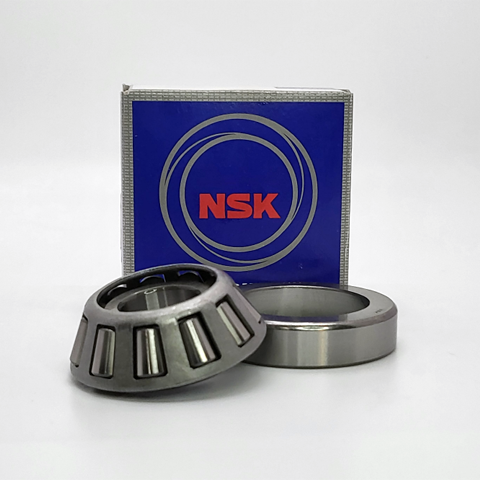
NSK NSK Tapered Roller Bearings, Single-Row Metric Design HR30311J ,D=55
NSK Tapered Roller Bearings, Single-Row Metric Design HR30311J ,D=55 Bearing Numbers Boundary Dimensions (mm) Basic Load Ratings (kN) Limiting Speeds (min-1) ISO355 Dimensions Series approx. Constant e Axial Load Factors Mass (kg) approx. d D T B C Cone r min. Cup r min. Cr C0r Grease Oil Y1 Y0 HR30311J 55 120 31.5 29 25 2.5 2 150 171 3200 4300 2FB 0.35 1.7 0.96 1.63 DESIGN, TYPES, AND FEATURES Tapered roller bearings are designed so the apices of the cones formed by the raceways of the inner and outer rings and the inner ring rollers all coincide at one point on the axis of the bearing. When a radial load is imposed, a component axial force occurs; therefore, it is necessary to use two bearings in opposition or some other multiple-bearing arrangement. For Metric Series medium-angle or steep-angle tapered roller bearings, the respective contact angle designation C or D is added after the bore number. For normal-angle tapered roller bearings, no contact angle designation is used. Medium-angle tapered roller bearings are primarily used for the pinion shafts of differential gears in automobiles. Some bearings with high load capacity (HR Series) contain a J suffix that indicates they conform to ISO specifications for outer ring back face raceway diameter, outer ring width, and contact angle. Therefore, the inner ring assembly and outer ring of bearings with a J suffix are internationally interchangeable. Some Metric Series tapered roller bearings specified by ISO 355 have different dimensions from past Series 3XX bearings. Some of these are listed in the bearing tables. These conform to ISO specifications for the small-end diameter of the inner ring and contact angle. The inner and outer ring assemblies are internationally interchangeable. The bearing designation structure, which has changed from the past, is listed below: Inch Series bearings also exist. Inner ring assemblies and outer rings are approximately formulated as follows (excluding four-row tapered roller bearings): Various arrangements of tapered roller bearings (excluding single-row bearings) are available. The cages of tapered roller bearings are usually made of pressed steel. Table 1 Design and Features of Tapered Roller Bearing Arrangements Design Arrangement Ex. Bearing Designation Features Back-to-back HR30210JDB+KLR10 Two standard bearings are combined. The bearing clearances are adjusted by inner ring spacers or outer ring spacers. The inner rings, outer rings, and spacers are marked with serial numbers and mating marks. Components with the same serial number can be assembled by referring to the matching indications. Face-to-face HR30210JDF+KR KBE Type 100KBE31+L The KBE type is a back-to-back arrangement of bearings with an integrated outer ring spacer. The KH type is a face-to-face arrangement in which the inner rings are integrated. Since the bearing clearance is adjusted using spacers, components must have the same serial number for assembly with reference to the matching indications. KH Type 110KH31+K
$109.52
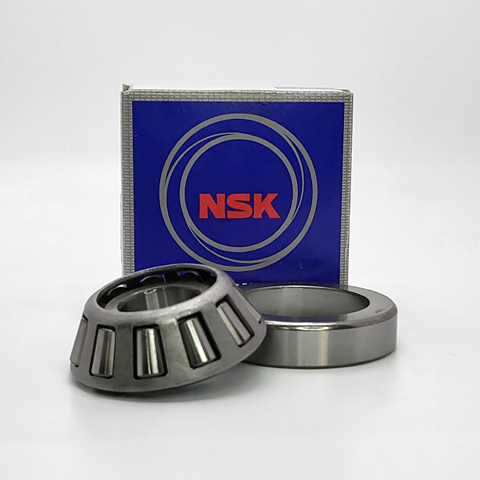
NSK NSK Tapered Roller Bearings, Single-Row Metric Design HR30310J ,D=50
NSK Tapered Roller Bearings, Single-Row Metric Design HR30310J ,D=50 Bearing Numbers Boundary Dimensions (mm) Basic Load Ratings (kN) Limiting Speeds (min-1) ISO355 Dimensions Series approx. Constant e Axial Load Factors Mass (kg) approx. d D T B C Cone r min. Cup r min. Cr C0r Grease Oil Y1 Y0 HR30310J 50 110 29.25 27 23 2.5 2 130 148 3400 4800 2FB 0.35 1.7 0.96 1.28 DESIGN, TYPES, AND FEATURES Tapered roller bearings are designed so the apices of the cones formed by the raceways of the inner and outer rings and the inner ring rollers all coincide at one point on the axis of the bearing. When a radial load is imposed, a component axial force occurs; therefore, it is necessary to use two bearings in opposition or some other multiple-bearing arrangement. For Metric Series medium-angle or steep-angle tapered roller bearings, the respective contact angle designation C or D is added after the bore number. For normal-angle tapered roller bearings, no contact angle designation is used. Medium-angle tapered roller bearings are primarily used for the pinion shafts of differential gears in automobiles. Some bearings with high load capacity (HR Series) contain a J suffix that indicates they conform to ISO specifications for outer ring back face raceway diameter, outer ring width, and contact angle. Therefore, the inner ring assembly and outer ring of bearings with a J suffix are internationally interchangeable. Some Metric Series tapered roller bearings specified by ISO 355 have different dimensions from past Series 3XX bearings. Some of these are listed in the bearing tables. These conform to ISO specifications for the small-end diameter of the inner ring and contact angle. The inner and outer ring assemblies are internationally interchangeable. The bearing designation structure, which has changed from the past, is listed below: Inch Series bearings also exist. Inner ring assemblies and outer rings are approximately formulated as follows (excluding four-row tapered roller bearings): Various arrangements of tapered roller bearings (excluding single-row bearings) are available. The cages of tapered roller bearings are usually made of pressed steel. Table 1 Design and Features of Tapered Roller Bearing Arrangements Design Arrangement Ex. Bearing Designation Features Back-to-back HR30210JDB+KLR10 Two standard bearings are combined. The bearing clearances are adjusted by inner ring spacers or outer ring spacers. The inner rings, outer rings, and spacers are marked with serial numbers and mating marks. Components with the same serial number can be assembled by referring to the matching indications. Face-to-face HR30210JDF+KR KBE Type 100KBE31+L The KBE type is a back-to-back arrangement of bearings with an integrated outer ring spacer. The KH type is a face-to-face arrangement in which the inner rings are integrated. Since the bearing clearance is adjusted using spacers, components must have the same serial number for assembly with reference to the matching indications. KH Type 110KH31+K
$84.68
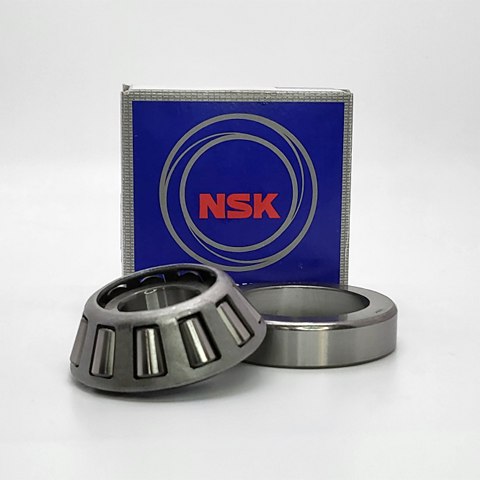
NSK NSK Tapered Roller Bearings, Single-Row Metric Design HR30309J ,D=45
NSK Tapered Roller Bearings, Single-Row Metric Design HR30309J ,D=45 Bearing Numbers Boundary Dimensions (mm) Basic Load Ratings (kN) Limiting Speeds (min-1) ISO355 Dimensions Series approx. Constant e Axial Load Factors Mass (kg) approx. d D T B C Cone r min. Cup r min. Cr C0r Grease Oil Y1 Y0 HR30309J 45 100 27.25 25 22 2 1.5 112 127 3800 5300 2FB 0.35 1.7 0.96 1.01 DESIGN, TYPES, AND FEATURES Tapered roller bearings are designed so the apices of the cones formed by the raceways of the inner and outer rings and the inner ring rollers all coincide at one point on the axis of the bearing. When a radial load is imposed, a component axial force occurs; therefore, it is necessary to use two bearings in opposition or some other multiple-bearing arrangement. For Metric Series medium-angle or steep-angle tapered roller bearings, the respective contact angle designation C or D is added after the bore number. For normal-angle tapered roller bearings, no contact angle designation is used. Medium-angle tapered roller bearings are primarily used for the pinion shafts of differential gears in automobiles. Some bearings with high load capacity (HR Series) contain a J suffix that indicates they conform to ISO specifications for outer ring back face raceway diameter, outer ring width, and contact angle. Therefore, the inner ring assembly and outer ring of bearings with a J suffix are internationally interchangeable. Some Metric Series tapered roller bearings specified by ISO 355 have different dimensions from past Series 3XX bearings. Some of these are listed in the bearing tables. These conform to ISO specifications for the small-end diameter of the inner ring and contact angle. The inner and outer ring assemblies are internationally interchangeable. The bearing designation structure, which has changed from the past, is listed below: Inch Series bearings also exist. Inner ring assemblies and outer rings are approximately formulated as follows (excluding four-row tapered roller bearings): Various arrangements of tapered roller bearings (excluding single-row bearings) are available. The cages of tapered roller bearings are usually made of pressed steel. Table 1 Design and Features of Tapered Roller Bearing Arrangements Design Arrangement Ex. Bearing Designation Features Back-to-back HR30210JDB+KLR10 Two standard bearings are combined. The bearing clearances are adjusted by inner ring spacers or outer ring spacers. The inner rings, outer rings, and spacers are marked with serial numbers and mating marks. Components with the same serial number can be assembled by referring to the matching indications. Face-to-face HR30210JDF+KR KBE Type 100KBE31+L The KBE type is a back-to-back arrangement of bearings with an integrated outer ring spacer. The KH type is a face-to-face arrangement in which the inner rings are integrated. Since the bearing clearance is adjusted using spacers, components must have the same serial number for assembly with reference to the matching indications. KH Type 110KH31+K
$70.80
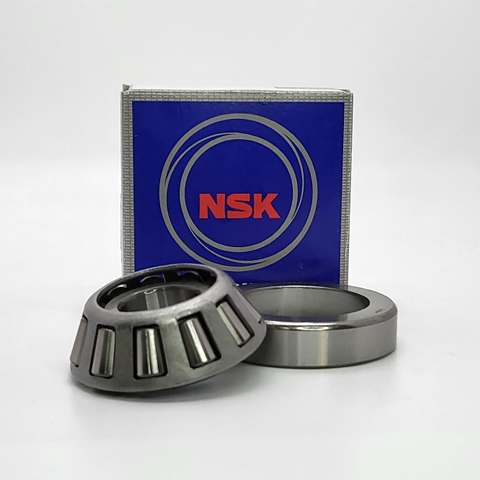
NSK NSK Tapered Roller Bearings, Single-Row Metric Design HR30308J ,D=40
NSK Tapered Roller Bearings, Single-Row Metric Design HR30308J ,D=40 Bearing Numbers Boundary Dimensions (mm) Basic Load Ratings (kN) Limiting Speeds (min-1) ISO355 Dimensions Series approx. Constant e Axial Load Factors Mass (kg) approx. d D T B C Cone r min. Cup r min. Cr C0r Grease Oil Y1 Y0 HR30308J 40 90 25.25 23 20 2 1.5 90.5 101 4300 5600 2FB 0.35 1.7 0.96 0.758 DESIGN, TYPES, AND FEATURES Tapered roller bearings are designed so the apices of the cones formed by the raceways of the inner and outer rings and the inner ring rollers all coincide at one point on the axis of the bearing. When a radial load is imposed, a component axial force occurs; therefore, it is necessary to use two bearings in opposition or some other multiple-bearing arrangement. For Metric Series medium-angle or steep-angle tapered roller bearings, the respective contact angle designation C or D is added after the bore number. For normal-angle tapered roller bearings, no contact angle designation is used. Medium-angle tapered roller bearings are primarily used for the pinion shafts of differential gears in automobiles. Some bearings with high load capacity (HR Series) contain a J suffix that indicates they conform to ISO specifications for outer ring back face raceway diameter, outer ring width, and contact angle. Therefore, the inner ring assembly and outer ring of bearings with a J suffix are internationally interchangeable. Some Metric Series tapered roller bearings specified by ISO 355 have different dimensions from past Series 3XX bearings. Some of these are listed in the bearing tables. These conform to ISO specifications for the small-end diameter of the inner ring and contact angle. The inner and outer ring assemblies are internationally interchangeable. The bearing designation structure, which has changed from the past, is listed below: Inch Series bearings also exist. Inner ring assemblies and outer rings are approximately formulated as follows (excluding four-row tapered roller bearings): Various arrangements of tapered roller bearings (excluding single-row bearings) are available. The cages of tapered roller bearings are usually made of pressed steel. Table 1 Design and Features of Tapered Roller Bearing Arrangements Design Arrangement Ex. Bearing Designation Features Back-to-back HR30210JDB+KLR10 Two standard bearings are combined. The bearing clearances are adjusted by inner ring spacers or outer ring spacers. The inner rings, outer rings, and spacers are marked with serial numbers and mating marks. Components with the same serial number can be assembled by referring to the matching indications. Face-to-face HR30210JDF+KR KBE Type 100KBE31+L The KBE type is a back-to-back arrangement of bearings with an integrated outer ring spacer. The KH type is a face-to-face arrangement in which the inner rings are integrated. Since the bearing clearance is adjusted using spacers, components must have the same serial number for assembly with reference to the matching indications. KH Type 110KH31+K
$56.58
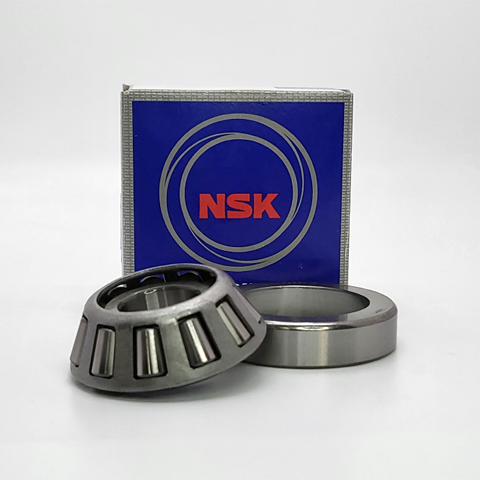
NSK NSK Tapered Roller Bearings, Single-Row Metric Design HR30307J ,D=35
NSK Tapered Roller Bearings, Single-Row Metric Design HR30307J ,D=35 Bearing Numbers Boundary Dimensions (mm) Basic Load Ratings (kN) Limiting Speeds (min-1) ISO355 Dimensions Series approx. Constant e Axial Load Factors Mass (kg) approx. d D T B C Cone r min. Cup r min. Cr C0r Grease Oil Y1 Y0 HR30307J 35 80 22.75 21 18 2 1.5 76 79 4800 6700 2FB 0.32 1.9 1.1 0.538 DESIGN, TYPES, AND FEATURES Tapered roller bearings are designed so the apices of the cones formed by the raceways of the inner and outer rings and the inner ring rollers all coincide at one point on the axis of the bearing. When a radial load is imposed, a component axial force occurs; therefore, it is necessary to use two bearings in opposition or some other multiple-bearing arrangement. For Metric Series medium-angle or steep-angle tapered roller bearings, the respective contact angle designation C or D is added after the bore number. For normal-angle tapered roller bearings, no contact angle designation is used. Medium-angle tapered roller bearings are primarily used for the pinion shafts of differential gears in automobiles. Some bearings with high load capacity (HR Series) contain a J suffix that indicates they conform to ISO specifications for outer ring back face raceway diameter, outer ring width, and contact angle. Therefore, the inner ring assembly and outer ring of bearings with a J suffix are internationally interchangeable. Some Metric Series tapered roller bearings specified by ISO 355 have different dimensions from past Series 3XX bearings. Some of these are listed in the bearing tables. These conform to ISO specifications for the small-end diameter of the inner ring and contact angle. The inner and outer ring assemblies are internationally interchangeable. The bearing designation structure, which has changed from the past, is listed below: Inch Series bearings also exist. Inner ring assemblies and outer rings are approximately formulated as follows (excluding four-row tapered roller bearings): Various arrangements of tapered roller bearings (excluding single-row bearings) are available. The cages of tapered roller bearings are usually made of pressed steel. Table 1 Design and Features of Tapered Roller Bearing Arrangements Design Arrangement Ex. Bearing Designation Features Back-to-back HR30210JDB+KLR10 Two standard bearings are combined. The bearing clearances are adjusted by inner ring spacers or outer ring spacers. The inner rings, outer rings, and spacers are marked with serial numbers and mating marks. Components with the same serial number can be assembled by referring to the matching indications. Face-to-face HR30210JDF+KR KBE Type 100KBE31+L The KBE type is a back-to-back arrangement of bearings with an integrated outer ring spacer. The KH type is a face-to-face arrangement in which the inner rings are integrated. Since the bearing clearance is adjusted using spacers, components must have the same serial number for assembly with reference to the matching indications. KH Type 110KH31+K
$48.92















































